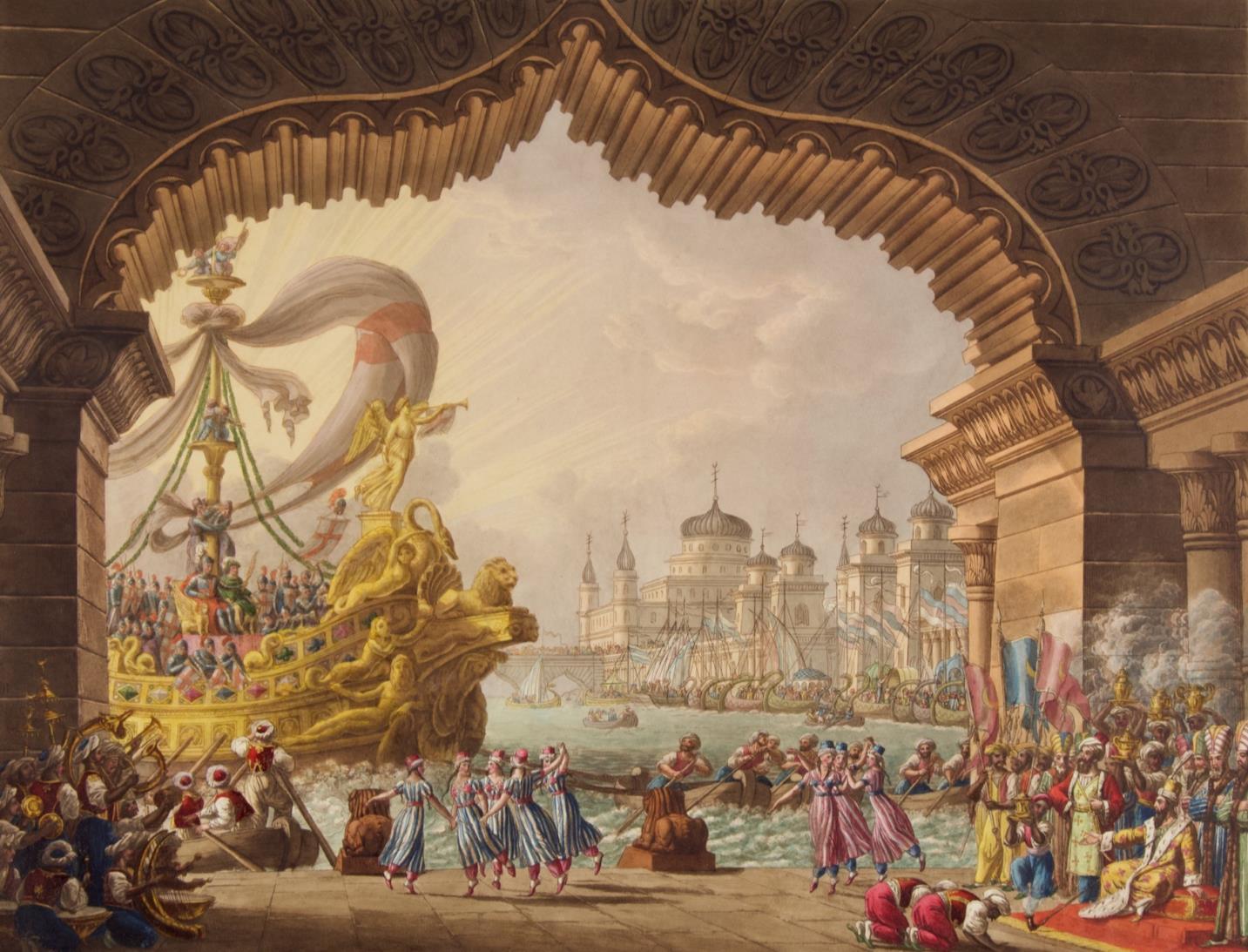
CONDITIONS OF SALE
Please order by catalogue name (or number) and either item number and title or inventory number (found in parentheses preceding each item’s price). Please note that all material is in good antiquarian condition unless otherwise described.
All items are offered subject to prior sale. We thus suggest either an e mail or telephone call to reserve items of special interest.
Orders may also be placed through our secure website by entering the inventory numbers of desired items in the SEARCH box at the upper right of our homepage. We ask that you kindly wait to receive our invoice to ensure availability before remitting payment. Libraries may receive deferred billing upon request
Prices in this catalogue are net. Postage and insurance are additional. New York State sales tax will be added to the invoices of New York State residents.
We accept payment by:
Credit card (VISA, Mastercard, American Express) PayPal to info@lubranomusic.com
Checks in U.S. dollars drawn on a U.S. bank International money order Electronic Funds Transfer (EFT), inclusive of all bank charges (details at foot of invoice) Automated Clearing House (ACH), inclusive of all bank charges (details at foot of invoice)
All items remain the property of J & J Lubrano Music Antiquarians LLC until paid for in full.
❖
Please visit our website at www.lubranomusic.com
where you will find full descriptions and illustrations of our entire inventory
❖ Members
Antiquarians Booksellers’ Association of America International League of Antiquarian Booksellers Professional Autograph Dealers’ Association Music Library Association American Musicological Society Dance Studies Association &c.
“A Magnificent, Ravishing Work that Penetrates the Heart”
1. BENDA, Georg 1722 1795
Romeo und Julie, einer Oper in drey Akten. [Piano vocal score]. Leipzig: Im Verlage der Dykischen Buchhandlung, 1778.
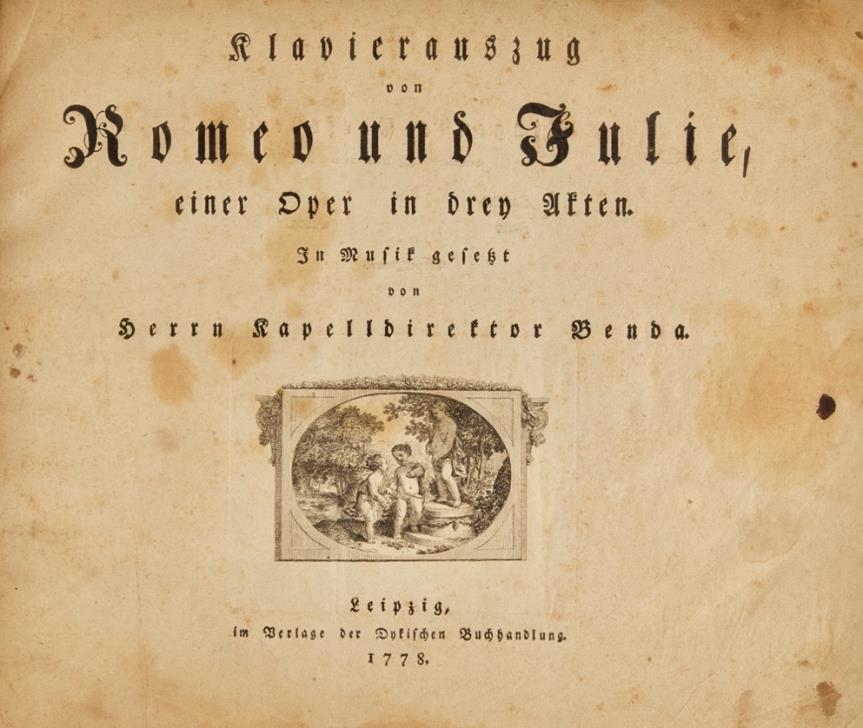
Oblong folio. Dark ivory cloth backed speckled boards. 1f. (recto title incorporating engraved vignette, verso cast list), 3 54 pp., 1f. (recto index of arias and songs, verso blank). Typeset music and text. With "Leipzig, gedruckt bey Johann Gottlob Immanuel Breitkopf" printed to foot of final page of music. Binding worn, rubbed, and bumped; spine frayed; upper detached. Uniform browning; minor foxing and staining; paper repair to outer edges of final leaf.
First Edition. BSB 2, p. 531, BUC p. 100, RISM B1883.
An opera in 3 acts to a libretto by Friedrich Wilhelm Gotter after William Shakespeare and Christian Felix Weisse, the present work was first performed in Gotha at the Schloss Friedenstein on 25 September 1776.
"[Benda] eliminated several characters and made Juliet rather than Romeo the centre of attention; his major alteration, the substitution of a happy ending in which Juliet awakes before Romeo can poison himself, aroused controversy from the start and seriously weakens an otherwise powerful, darkling work. Musical attention centres on Juliet and her confidante Laura (both sopranos), the latter part written for Benda’s daughter Justel. The score is completely in the style of opera seria except that spoken dialogue replaces simple recitative, a decision Benda pointedly defended in print. Juliet’s best music comes in free flowing monologues, against which Romeo (tenor) cuts a poor figure on the whole. Romeo und Julie was taken up by nearly every major theatrical company in Germany and saw performances well into the 19th century. In 1780 J. F. Reichardt praised it as ‘a magnificent, ravishing work that penetrates the heart!’ but added: ‘If only the poet had not cut up his material so irresponsibly into well behaved, everyday opera garb!’ " Thomas Bauman in Grove Music Online (38703) $650
A Striking Association Copy,
2. BERNSTEIN, Leonard 1918-1990
The Joy of Music. Inscribed to Bernstein's teacher, conductor Fritz Reiner, and signed "Devotedly Lenny." New York: Simon and Schuster, 1959.
Octavo. Full dark gray cloth with small illustration of a conductor to upper in black, titling silver to upper and spine, purple endpapers. 303, [i] (blank) pp., 1f. (recto "About the Author," verso blank). With illustrations and numerous musical examples in text. In pictorial dustjacket. Dustjacket worn, with small tears and very minor loss.
Inscribed to the distinguished conductor Fritz Reiner on front free endpaper "For Fritz, Who taught me so much about teaching, and about music Devotedly, Lenny."
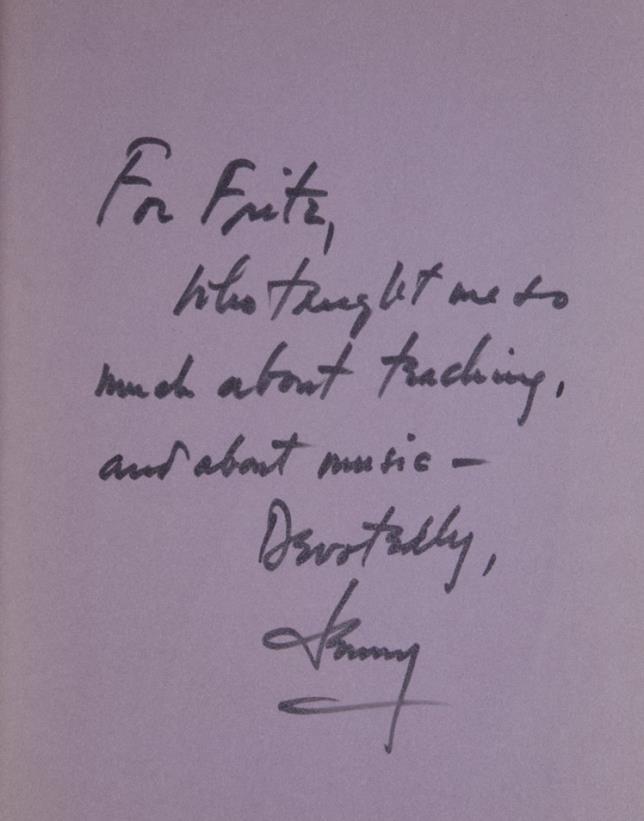
"His accomplishments as a conductor, composer of musical theater and concert works, and musical educator through television mark Bernstein as an unusually versatile figure. Among his most lasting contributions are his tenure as music director of the New York Philharmonic and the score to the Broadway musical West Side Story." Paul R. Laird and David Schiff in Grove Music Online
Reiner (1888 1963), a distinguished American conductor of Hungarian birth, taught conducting at the Curtis Institute of Music in Philadelphia from 1931 to 1941, where his pupils included Bernstein and Lukas Foss.
A unique association item linking two of the most distinguished conductors of the 20th century, with Bernstein acknowledging the significant influence that Reiner had on both his teaching and his musical philosophy (38753) $1,450
Inscribed by Leonard Bernstein to Fritz Reiner16th Century Dance, with 22 Finely-Engraved Plates
“A Beautiful Book”
“ A Centrally Important Book on the Dances of the Time” With Distinguished Provenance
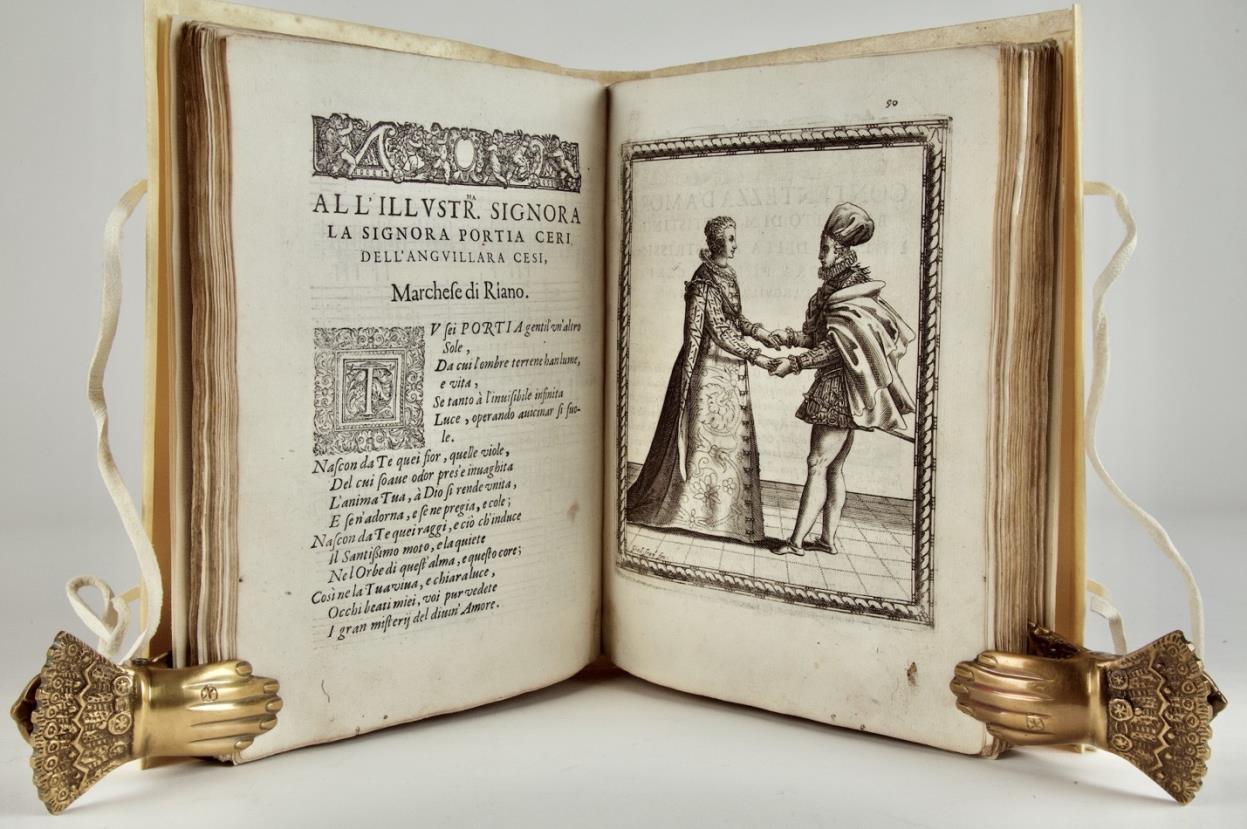
3. CAROSO, Fabrizio 1526/1535 after 1605
Il Ballarino di M. Fabritio Caroso da Sermoneta, Diviso in due Trattati; Nel primo de' quali si dimostra la diversità de i nomi, che si danno à gli atti, & movimenti, che intervengono ne i Balli ... & con molte Regole si dichiara con quali creanze, & in che modo debanno farsi. Nel secondo s'insegnano diverse sorti di Balli, & Balletti sì all'uso d'Italia, come à quello di Francia, & Spagna. Ornato di Figure. Et con l'Intavolatura di Liuto, & il Soprano della Musica nella sonata di ciascun Ballo. Opera nuovamente mandata in luce. All Serenma. Sigra. Bianca Cappello de Medici, Gran Duchessa di Toscana. Con Privilegio. Venetia: Apresso Francesco Ziletti, 1581.
Quarto. Newly bound in full ivory vellum with leather ties. 1f. (recto title, verso blank), 6ff. (dedications, etc.), 1f. (recto blank, verso fine bust length engraved portrait of the author), 16ff. ("Trattato Primo"), 1f. (recto title to "Trattato Secondo," verso blank), 184ff. (final page blank), + 4ff. (index, errata, register for the binder, and colophon). With highly decorativeandhistoriatedwoodcutinitials andheadpieces throughout. Allleaves printed on both sides, numbered on rectos only. With early limp vellum covers preserved in separate archival folder. The whole in a dark blue buckram clamshell box with printed paper label to spine.
With 22 fine full page engraved plates in total, including the portrait, all signed by Giacomo Franco and printed on integral leaves; 21 of the plates depict dancers in highly detailed costume illustrating seven positions for dance partners (five repeated), hand and foot positions, etc.
The Trattato Primo describes thesteps andhow toperform themin54rules;the Trattato Secondo describes 81 dances, each with its own dedicatee. With 79 pages of musical notation in typeset lute tablature.
Provenance
From the library of the noted English early music specialist Arnold Dolmetsch (1858 1940), with his small handstamp ("Dolmetsch Library") to foot of verso of title.
Occasional minor signs of wear and soiling; small chips to outer corners of title professionally repaired; very occasional mispagination and small stains; worming to blank lower inner margins, most noticeable to pp. 25 150, and occasionally to blank outer margins. A very good, crisp, and wide margined copy overall.
First Edition, second issue (with Ziletti's device on the title page instead of the arms of Bianca Capello 1548 1587, second wife of Francesco de'Medici, Grand Duke of Tuscany).

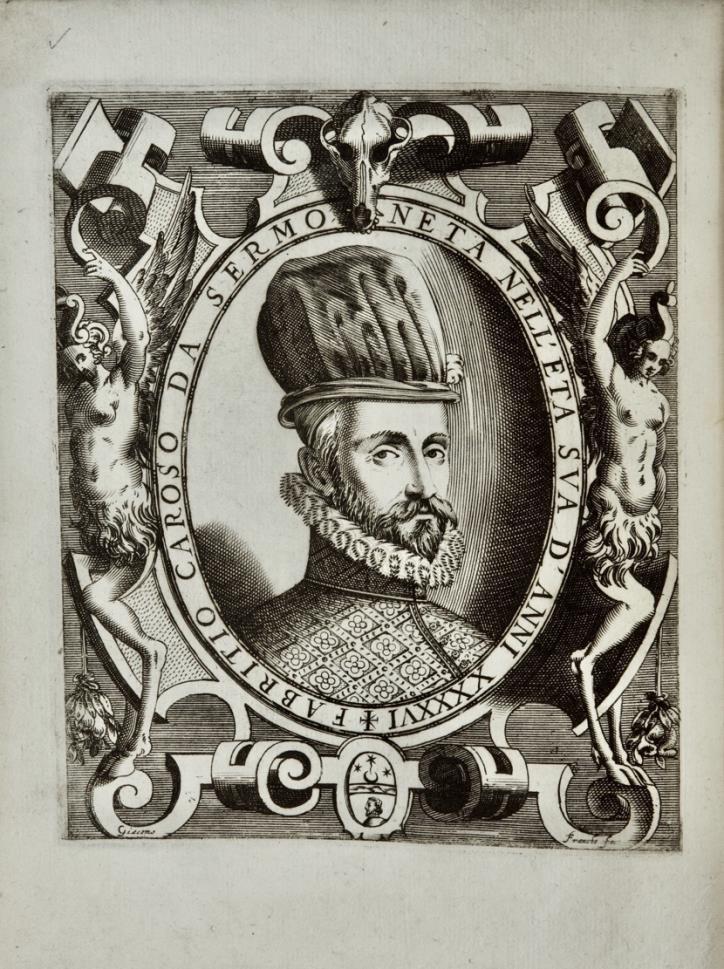
Malkin no. 16. Derra de Moroda 527. RISM BVI p. 207 (notdistinguishing betweenissues). Cortot p. 45. Hirsch I, 100. Fletcher 4. Beaumont pp. 24 25. Niles & Leslie I, pp. 86 87. Magriel pp. 43 44.
"A centrally important book on the dances of the time: their steps, figures, and music. The engravings by Giacomo Franco make this one of the finest early books on dance. With Negri's Le gratie d'amore, 1602 ... Caroso's two manuals, Il ballarino and Nobiltà di dame, ... are the principal sources for our knowledge of the dances of the late Italian Renaissance." Malkin p. [28].
"A beautiful book which, apart from its importance as a classic of early literature on the Dance, is remarkable for its fine engravings by Giacomo Franco, its initial letters and the typographical charm of its pages. This work sets down in great detail the manner of execution of the dances fashionable at the courts of France, Italy and
Spain during the Middle Ages. Herein are described Menuets, Galliardes, Caprioles, Canaries, Pavanes and many kinds of Branles, together with their airs. These are accompanied by musical notations for the lute. ... The illustrations (several of which are repeated) show the correct position of the body and limbs at different stages in the measures, the manner of holding hands, making a reverence, etc. The engravings are full length representations of both ladies and gentlemen and the costume of the epoch is rendered with a valuable wealth of detail. An excellent engraving of the author will be found facing page 1." Beaumont
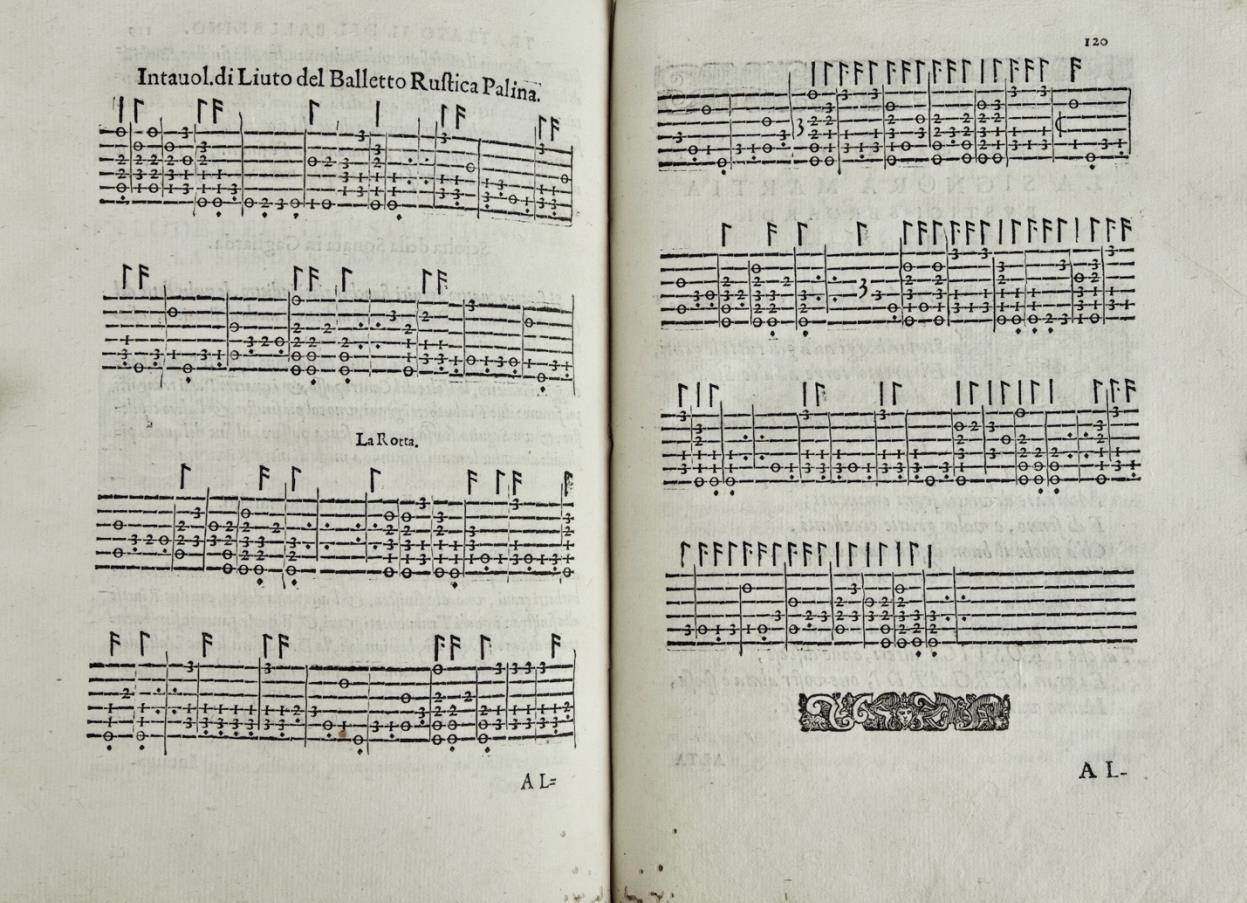
Dolmetsch was an "English instrument maker and pioneer in the revival of performances of early music on original instruments. ... [His] great gift was that, in a period when early music was virtually ignored except for academic study, he had both the imagination and the musicianship to take a musical work that had become a museum piece and to make it speak to the people of his own time in a language intelligible to them. He wrote the book The Interpretation of the Music of the XVII and XVIII Centuries …” Margaret Campbell, revised by Katherine K. Preston in Grove Music Online
A very good copy of this important work, with distinguished provenance. (38595) $11,500
Large Autograph Musical Quotation from Falstaff, Elgar’s “Most Explicit Programme Music”
4. ELGAR, Edward 1857 1934
Large 9 measure autograph musical quotation from Falstaff, boldly penned on the occasion of the premiere of the work, signed in full by the composer.
Two full lines of notation, in black ink, with "Falstaff" at head, marked "Allegro," and signed "Edward Elgar" at conclusion. On a sheet of music manuscript paper ca. 170 x 262 mm. Slightly worn and soiled; creased at folds; cut down from a larger sheet, lower margin slightly ragged.
With "Falstaff" and a key signature to verso in the composer's autograph together with a manuscript note to lower left corner "Given me by R.A. Streatfield Esq. Dec. 17th 1913 for whom these bars were written out by Sir Edward Elgar at the Leeds festival, Oct. 1913, for publication in The Daily Graphic." (The present quotation was, in fact, reproducedinan articlein The Daily Graphic onOctober 3, 1913;acopy ofthatarticleaccompanies this autograph musical quotation).
With small (51 x 85 mm.) original photograph of Elgar conducting, in all likelihood the premiere of the present work, laid down to upper right portion of leaf.

Falstaff, a symphonic study in C minor, Op. 68, was first performed in Leeds at the Town Hall on 1 October 1913, with the composer conducting.
"Falstaff (1913), Elgar's most explicit programme music, is a ripe and genial study of a big spirited man. It is his largest instrumental movement, masterly in having so many strong themes which can be treated in witty fugal devices or run together contrapuntally to illustrate the action. Elgar's attitude to Falstaff was protective, his view partial, drawn only from Shakespeare's Henry IV and Henry V, and in his analysis he credits Morgann's essay of 1777. Flatterer, braggart, charmer and law breaker he may be, but this Falstaff is above all a gentleman. The tavern scene is mild, neither bawdy nor erotic. Though Elgar could compose a passionate apotheosis, there is scarcely a trace of eroticism in his music. Bearing in mind the voluptuous sounds of such contemporaries as Rachmaninoff, Strauss or Puccini, it would seem that Elgar’s chaste instincts were fostered by the Victorian world in which he grew up. Chaste is a word few would use about Falstaff, yet it describes the interludes, both of innocence regained, first in a dream of youth, then in a country orchard. Falstaff's final ‘rejection’ by the new king and his death are so heart rending that one sees in them Elgar's own fears he was not deaf to the changes of taste in 1913 that he too might be rejected by the new musical regime."
Best known today for his Enigma Variations, Elgar's "abundant invention, largeness of vision, and strength and singularity of musical character place him high among European Romantic artists and at the peak of British music of his time. He drew inspiration from the culture and landscape of his own country, resourcefulness from the study of his continental colleagues; and contributed to all the major forms except opera, creating a significant body of symphonic literature, the finest oratorio by an Englishman, and in his popular music a style of direct national appeal." Diana McVeagh in Grove Music Online
Richard Alexander Streatfield (1866 1919) was a British writer on music and music critic. (38752) $2,650
Rare First Edition, With Music and Choreographic Notation to 32 Contredanses
5. FEUILLET, Raoul Auger 1659/60 1710

Recüeil de Contredances mises en Chorégraphie, d'une maniére si aisée, que toutes personnes peuvent facilement les apprendre sans le secours d'aucun maître et même sans avoir eu aucune connoissance de la Chorégraphie. Par Mr. Feüillet. Maître et Compositeur de Dance. Paris: L'Auteur Rüe de Bussi Faubourg Saint German à la Cour Imperiale pres la rüe des mauvais garçons Avec Privilège du Roy, 1706.
Small octavo. Full 18th century dark brown mottled calf with raised bands on spine in decorative compartments gilt, decorative board edges gilt. 1f. (recto title, verso blank), 1f. (dedication to Madame La Duchesse du Maine), 1f. ("Préface"), 13ff. ("Eléments, ou Principes de Chorégraphie"), 192 pp., with "Table" to recto of final leaf and "Privilége" to verso. Engraved throughout. Binding slightly worn, rubbed, and bumped, with very minor loss to head and tail of spine; endpapers slightly soiled and browned at edges. Minor wear and browning; very small ink stains to blank lower margin of title and following four leaves; one small wormhole to blank lower margin through p. 57; occasional very small holes to blank areas. A very good copy overall.
With music and accompanying choreographic notation to 32 contredanses for 4 couples.
Provenance
From the library of the noted English early music specialist Arnold Dolmetsch (1858 1940), with his small handstamp ("Dolmetsch Library") to foot of verso of title.
First Edition. Rare. Derra de Moroda 931. Hirsch I, 172. Niles & Leslie I, p. 165. Lesure p. 697 (three copies only recorded). Not located in RISM.
Feuillet, a French choreographer, dancing master and author, "worked at the court of Louis XIV. His fame rests on his Chorégraphie [Paris, 1700], a book describing a system of dance notation that was used in Europe throughout the 18th century. He probably did not invent the system himself (although he said he had) but derived it from the original work of Pierre Beauchamps, Louis XIV's personal dancing master. Unlike previous methods, which describe movement verbally and use letters to refer to the sequence of steps, Feuillet's system is a track notation. It represents symbolically not only the steps of the dancer, with his turns, leaps and slides, but also the floor pattern in which he is to travel. The dance music is printed at the top of the page, and the steps are marked off in a manner corresponding to the structure of the music ...
"The publication of the Beauchamp Feuillet notation meant that specific dances could easily be distributed throughout Europe. It also added to France's pre eminence in the world of dance. Today the system makes it possible for scholars to study some of the dances in use in the late 17th and early 18th centuries, an important period for the development of the classical French ballet style and technique." Meredith Ellis Little in Grove Music Online
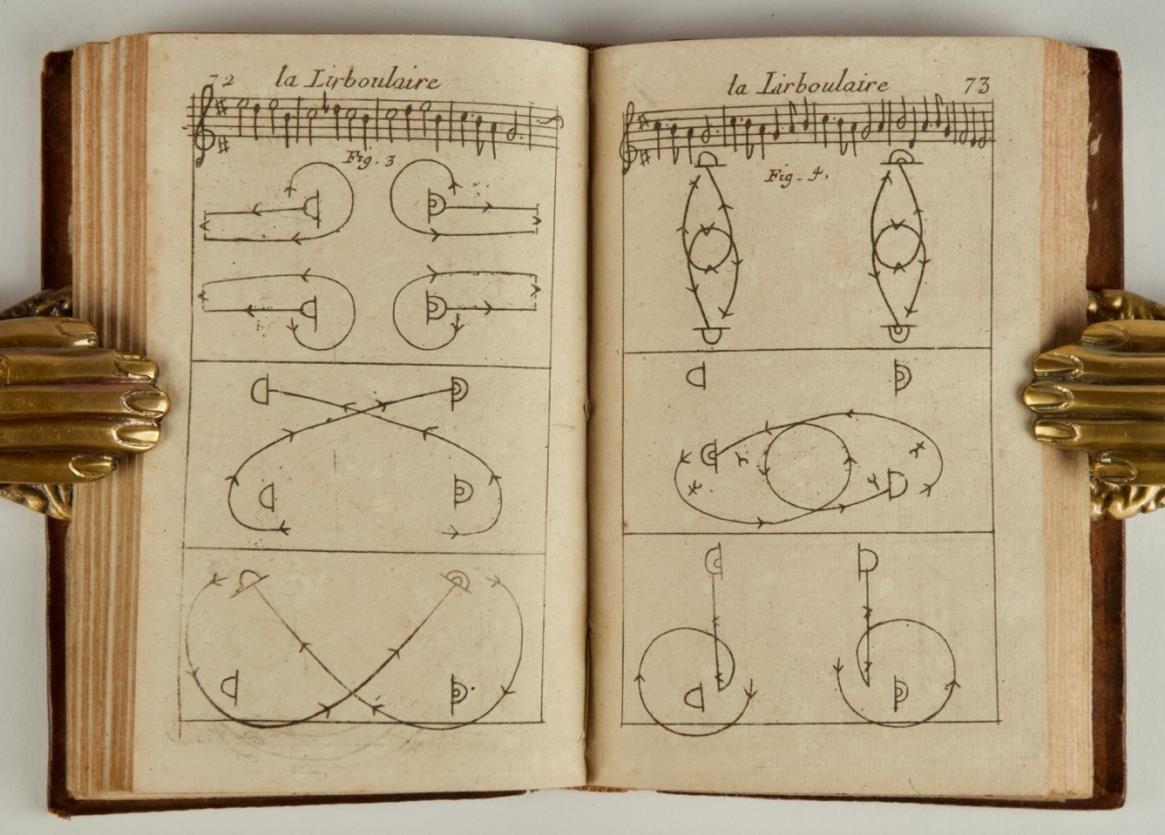
The present work "contains a simplified explanation of some elements of chorégraphie, here adapted for the notation of contredanses. The opening section entitled: 'Elements ou principes de chorégraphie'... describes the symbols for the track, feet, hands, and arms; the steps; and the relation of floor patterns to musical notation. The subsequent section of notated contredanses provides music and floor patterns for 32 dances, each for 4 couples." Schwartz and Schlundt: French Court Dance and Dance Music, p. 33.
Dolmetsch was an "English instrument maker and pioneer in the revival of performances of early music on original instruments. ... [His] great gift was that, in a period when early music was virtually ignored except for academic study, he had both the imagination and the musicianship to take a musical work that had become a museum piece and to make it speak to the people of his own time in a language intelligible to them. He wrote the book The Interpretation of the Music of the XVII and XVIII Centuries …” Margaret Campbell, revised by Katherine K. Preston in Grove Music Online
A
good
this important
6. HANDEL, George Frideric 1685 1759 [HWV 426 442]. Suites de Pieces Pour le Clavecin [Volumes I and II, complete] London: John Walsh [PN 490], [ca. 1736, ca. 1733].
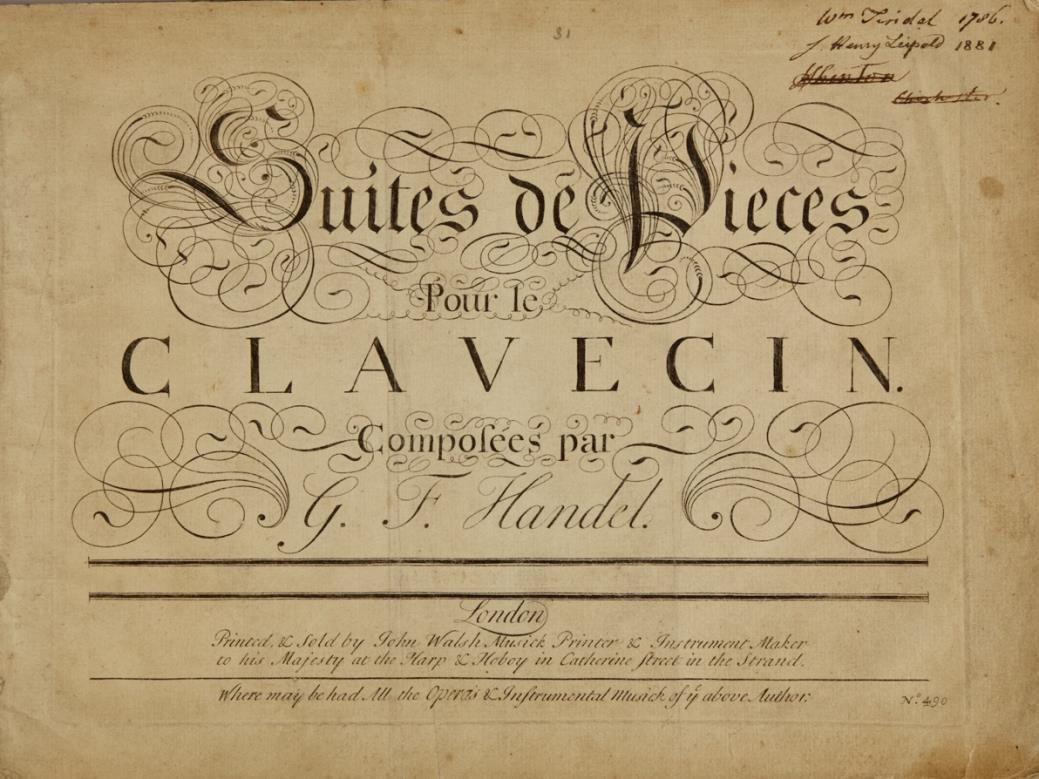
Oblong folio. Engraved throughout. With early performance markings (trills, etc.) and occasional modern annotations in pencil
Vol. I: 1f. (recto decorative calligraphic printed title, verso blank), [i] (blank), 94, [i] (blank) pp. Stiff plain modern wrappers with manuscript titling to upper. Ownership inscription to title "Wm Tindal 1786 / J. Henry Leipold 1881," with third name "[?]JShenton Chichester" (possibly related to the composer, Rev. Robert Shenton, 1750 1798) crossed out. First Edition, 4th issue. Smith p. 250, no. 6. Hoboken 5, 171, RISM H1433.
Vol. II: 1f. (recto calligraphic printed title, verso blank), [i] (blank), 2 83, [i] (blank) pp. Contemporary dark brown mottled calf boards with dark red leather label with titling within ornate gilt border to upper, single gilt rule to edges, raised bands on spine in gilt ruled compartments. With ownership inscription "S.H. [?]Emett" to front pastedown. First Edition, [?]first issue. Smith p. 249, no. 5. Hoboken 5, 173. RISM H1438.
Provenance
From the library of the noted English early music specialist Arnold Dolmetsch (1858 1940), with his small handstamp ("Dolmetsch Library") to foot of verso of title to both volumes.
Wrappers to Vol. I worn and soiled; boards to Vol. II worn, rubbed, and bumped, with several abraided areas; upper board and free front endpaper detached. Slightly worn, browned, and soiled; very occasional foxing; vertical crease and small marginal tear to title to Vol. I with small binder's holes to inner margins; edges and rear endpapers of Vol. II browned.
One of the Most Famous Sets of Keyboard Music Published in the 18th Century"The most important volume among the early printed collections of keyboard music is Handel’s own issue of Suites de Pieces pour le Clavecin … Première Volume, which appeared in November 1720. In a preface Handel explained that he had been ‘obliged to publish some of the following Lessons because surrepticious and incorrect copies of them had got abroad’ apparently a reference to a pirated edition of keyboard pieces prepared by Walsh and issued under the imprint of Jeanne Roger of Amsterdam about the same time. (It is not clear whether the Roger volume actually appeared before Handel’s own.) The eight suites of the 1720 set draw upon the keyboard works of both the Hamburg and English periods, but many movements were revised, five of the fugues were included in the suites and seven new movements were added. Handel supervised the publication: emendations made to the plates at proof stage and visible in some copies can only have been the composer’s. The varied origins of the music make the collection a microcosm of Handel’s stylistic eclecticism." Anthony Hicks in Grove Music Online
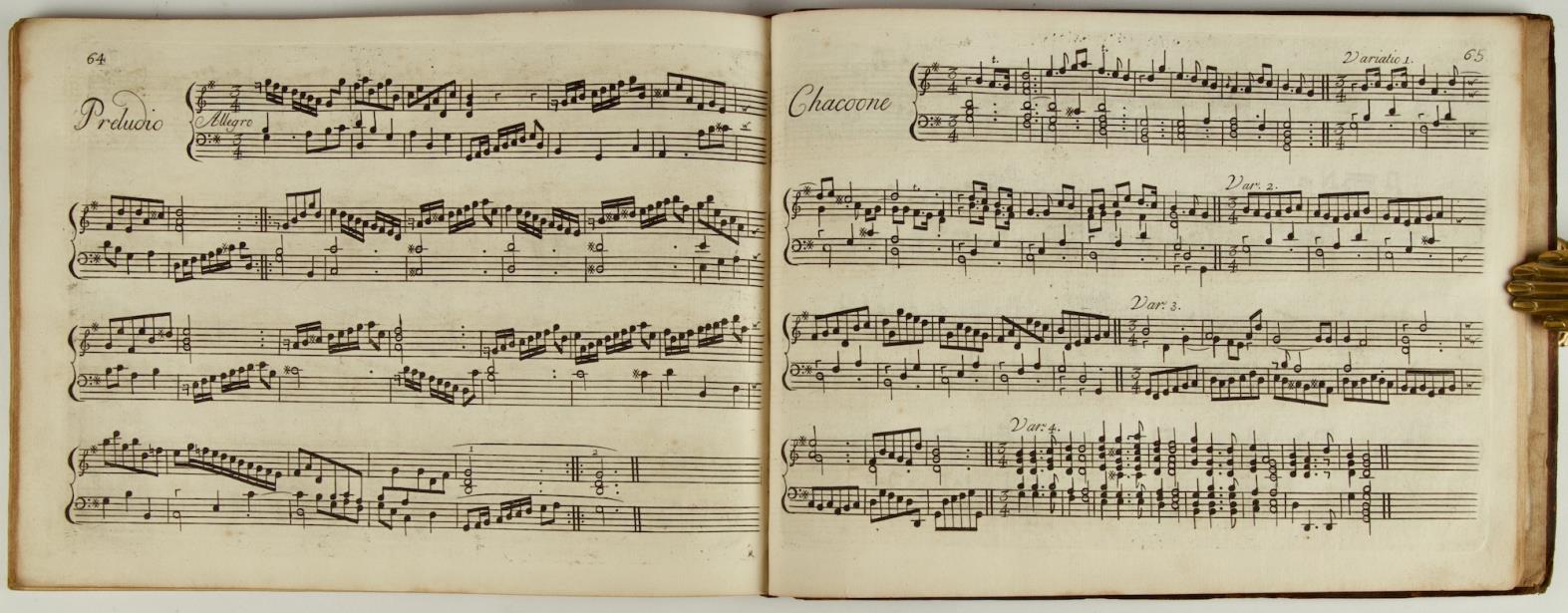
"Possibly as a result of these lessons, keyboard music by Handel began to circulate in manuscript and within two years he was obliged to publish his own edition of Suites de Pièces de Clavecin (preferring the French title to the normal 'Harpsichord Lessons') with the preliminary note:
I have been obliged to publish some of the following Lessons, because surrepticious and incorrect Copies of them had got Abroad. I have added several new ones to make the work more usefull, which if it meets with a favourable Reception; I will still proceed to publish more, reckoning it my duty, with my Small Talent, to serve a Nation from which I have receiv'd so Generous a protection. Amongst these suites is the set of variations to which the nineteenthy century attached the title of 'The Harmonious Blacksmith', a mythical melodist said to have been resident at Whitchurch, close to Cannons." Hogwood: Handel, pp. 74 75.
Dolmetsch was an "English instrument maker and pioneer in the revival of performances of early music on original instruments. ... [His] great gift was that, in a period when early music was virtually ignored except for academic study, he had both the imagination and the musicianship to take a musical work that had become a museum piece and to make it speak to the people of his own time in a language intelligible to them. He wrote the book The Interpretation of the Music of the XVII and XVIII Centuries …" Margaret Campbell, revised by Katherine K. Preston in Grove Music Online
Quite a nice copy of one of the most famous sets of keyboard suites published in the 18th century, with distinguished provenance. (38598) $2,950
Mid 19th Century Opera in Weimar under Liszt and Dingelstedt, With Excerpts from a Lengthy Unpublished Liszt Letter
7 [LISZT]. Pasqué, Ernst Heinrich Anton 1821 1892
A group of three autograph manuscript documents relating to an unpublished article on Pasqué's life and observations as director of the Opera in Weimar under Franz Liszt and Franz Dingelstedt from 1856 to 1859 including Pasqué's partial transcription and commentary on an 8 page unpublished letter Liszt wrote to him. Text in German throughout.
1
A draft entitled Unter den beiden Franzen: Weimarer Erlebnisse 1856 1859, divided into chapters: I: Franz Dingelstedt and Weimar: Pre history 1850; II: Franz Dingelstedt in Munich and his arrival in Weimar, 1850 1857; III: Dingelstedt's first actions in Weimar; IV: Dingelstedt as General Intendant; V: Untitled; VI: Untitle; Conclusion: A final statement titled Now let us turn to friendlier images, the second of the Franzes and the complete opposite of the first, Dr. Franz Liszt and his activity in Weimar
Large quarto. Unbound. 26 closely written pages with extensive corrections and additions including overpastes and tipped in sheets. In ink on Pasqué's letterhead, the first page dated Alsbach, 17 February 1892.

2
A prospectus of the article, possibly intended to be submitted to a publisher, including a significant transcription of at least two pages of an apparently unpublished 8 page letter written by Liszt to Pasqué dated 30 October 1859. With a detailed commentary by Pasqué on the circumstances surrounding the letter. Folio. 4 pp. Dated March 1892.
Excerpts from Liszt's letter: "Your current position offers you, among other things, also this excellent benefit: to further develop, at greater leisure than before, the literary talent and skills that distinguish you. To begin with, I am pleased to hear that you will not neglect Weimar and, for now, are working on the history of [its] music and theater from 1500 to 1774." The composer goes on to say that it should be easy to find a publisher for such a work, and suggests that if Böhlau cannot take on the project that he should contact Liszt's friend Brendel in Leipzig who "will be surely pleased to find a suitable and proactive publisher for it ... My activity as Kapellmeister and conductor is coming to its complete end ... I am firmly determined to no longer accept the direction of concerts or music festivals anywhere. I will limit myself to a few appearances promised long ago (maybe in Prague). Henceforth, my time shall be devoted to my work as a composer only ..."
In Pasqué's commentary on the circumstances of the letter, he goes on to mention his "double duty" in Weimar as both operatic stage director and onstage participant, using his leisure time to research documents in various archives in an effort to gather material for his history of music and theatre at the Weimar court over three centuries, about which he has spoken to Liszt. "I had also hinted at my plan to write a report on my personal
experience and my experience as an operatic stage director at the Weimar Court Theater (under Dingelstedt), my intention mainly being to expose Dingelstedt's conduct vis à vis Liszt openly and truthfully, a conduct that was destined to lead to the latter's downfall, which might have served to explain some events that hitherto had remained enigmatic ..."
3
A supplement, written as a summation of the above referenced article and, again, possibly intended to be submitted to a potential publisher. Quarto. 1 page. Undated, but 1892. Titled “Under Franz Liszt and Franz von Dingelstedt / Weimar experiences by Ernst Pasqué.”
[Part] I
The two Franzes Dingelstedt and his stage directors, his Kapellmeister and the "old G [...]
Dingelstedt and "old" Winterberger, a Hamlet rehearsal, "Throw him in to the ditch"
A Mozart comedy in progress [...] and Anna Amalia
A Mozart celebration under Goethe, 1792, and the first German Mozart monument, from Weimar's "golden" era, 1799
A Mozart celebration and the 100th performance of The Magic Flute under Dingelstedt, 1858, and its aftermath
[Part] II
A second essay would be mainly focused on Liszt and would cover some interesting events, news from his time as court Kapellmeister, and some letters. The first Lohengrin performance in 1849. Also the first performance of Cornelius's opera Der Barbier von Bagdhad (which I had to stage), the [?]subsequent dispute in the press and, finally, from the Barber to the Abbé. This article would be longer (Pasqué died before he could write this second essay).
[Parts] III, IV
How I found my Goethe [...]. Their history and content. What has stayed with me after my publication of "Goethes Theaterleitung in Weimar." Some new episodes and additions to those previously published.
Pasqué died on 20 March 1892, the same month he dated the prospectus (item 2 above); he was thus not able to write the second portion of his article, intended to be largely devoted to his time at the Weimar Opera under Franz Liszt.
Liszt wrote a letter dated Weimar, 28 October 1859 to FranzBrendel (1811 1868), editor of the Neue Zeitschrift für Musik in Leipzig, suggesting Pasqué as an author and prospective new contributor to the prestigious music journal;thisletteris held bytheLibrary ofCongress. Itwas writtenjust 2days beforetheapparentlyunpublished 8 page letter Liszt wrote to Pasqué from which Pasqué transcribes and provides commentary in the present manuscript material. It would seem likely that Pasqué, withLiszt's encouragement, may have intended to submit the present article, including the yet to be written second part, to Brendel for possible publication in the Neue Zeitschrift für Musik.
Pasqué was a musician and author. Born in Cologne, he went to Paris at the age of 17, where he studied singing under Lütgen at the church of Notre Dame de Lorrette and later with Delsart. He was admitted to the Paris Conservatoire in 1842. He met Conradin Kreutzer in 1843 for whom he wrote a libretto, and the two men had a close association up until Kreutzer's death. Pasqué returned to Germany and subsequently took singing roles at theaters in Aachen, Mainz, Darmstadt, and Leipzig. He also appeared in Amsterdam, London, and Ghent. In 1855, he was engagedas Managerof theGermanOpera inAmsterdam, and in 1856took up the position of opera director under Franz Liszt and Franz Dingelstedt. He authored some 22 opera libretti between 1845 and 1882. In addition to writing for opera, Pasqué authored some 40 works of both fiction and non fiction. Of some historical importance is his Goethe's Theaterleitung in Weimar, Leipzig, 1863. Excerpted from Deutsche Biographie online. (38708) $750
8. MACE, Thomas ?1612 13 ?1706
Musick's Monument; or, a Remembrancer of the best Practical Musick, both Divine, and Civil, that has ever been known, to have been in the World. Divided into Three Parts. The First Part, Shews a Necessity of Singing Psalms Well, in Parochial Churches, or not to Sing at all; Directing, how They may be Well Sung, Certainly; by Two several Ways, or Means; with an Assurance of a Perpetual National Quire; and also shewing, How Cathedral Musick, may be much Improved, and Refined. The Second Part, Treats of the Noble Lute, (the Best of Instruments) now made Easie; and all Its Occult Lock'd up Secrets Plainly laid Open, never before Discovered; ... Directing the most Ample Way, for the use of the Theorboe ... Shewing a General Way of Procuring Invention, and Playing Voluntarily, upon the Lute, Viol, or any other Instrument; with Two Pritty Devices; the One, shewing how to Translate Lessons, from one Tuning, or Instrument, to Another; The other, an Indubitable Way, to know the Best Tuning, upon any Instrument ... In the Third Part, The Generous Viol ... is Treated upon; with some Curious Observations, never before Handled, concerning It, and Musick in General. London: Printed by T. Ratcliffe, and N. Thompson, for the Author, and are to be sold by Himself, at His House in Cambridge, and by John Carr, at His Shop at the Middle Temple Gate in Fleet Street, 1676.

“The Lute Made Easie”
First Edition of an Important Work on 17th Century English Music From the Library of Noted English Early Music Specialist Arnold Dolmetsch
Folio. Full dark brown mottled panelled calf with raised bands on spine in gilt ruled compartments, dark redtitle label gilt. Pencilled notes to verso of blank preliminary leaf. Binding somewhat worn, rubbed, and bumped; small portion of leatherlacking to lower outer corners of both boards and outer edge of lower; rebacked and with modern endpapers. Frontispiece trimmed and laid down, with minor loss to oval border, edges slightly chipped. Minor browning, foxing, and soiling, slightly heavier to edges; small portion of blank upper margin of pp. 47/48 lacking; small hole to blank area of pp. 145/146; p. 154 mis numbered 159 and p. 159 mis numbered 154. A good, wide margined, and crisp copy overall, with strong impression.
1f. (recto blank, verso frontispiece portrait of Mace by Faithorne after Cooke), 1f. (recto title, verso blank), [i] ("The Epistle Dedicatory"), [iii] ("An Epistle to all Divine Readers"), [v] ("The Preface"), [ii] ("A Short Epistle of Thanksfulness, To all my Noble Subscribers"), [iv] ("The Subscribers Names"), [i] (blank), [i] ("A Short Epistle to the Reader, concerning the Authors several Reasons for Writing This Book"), [i] ("An Advertisement, Concerning the Value and Price of the Book"), 272 pp. Musical examples throughout. With decorative woodcut initials and headpieces. With distinguished list of subscribers including [Sir] Isaac Newton ("Mr's of Arts, and Fellows"), and James and Thomas Lawes ("Masters in Musick").
With three full page engraved plates, as follows:
A 50 stringed lute that Mace called a dyphone, or double lute (a combination lute/theorbo) designed to compensate for the author's increasing deafness (p. 32)
A "Description of a Musick Room" demonstrating Mace's interest in acoustic challenges (p. 239)
A table organ, together with a considerable quantity of lute music in tablature, some composed by Mace (p. 243)
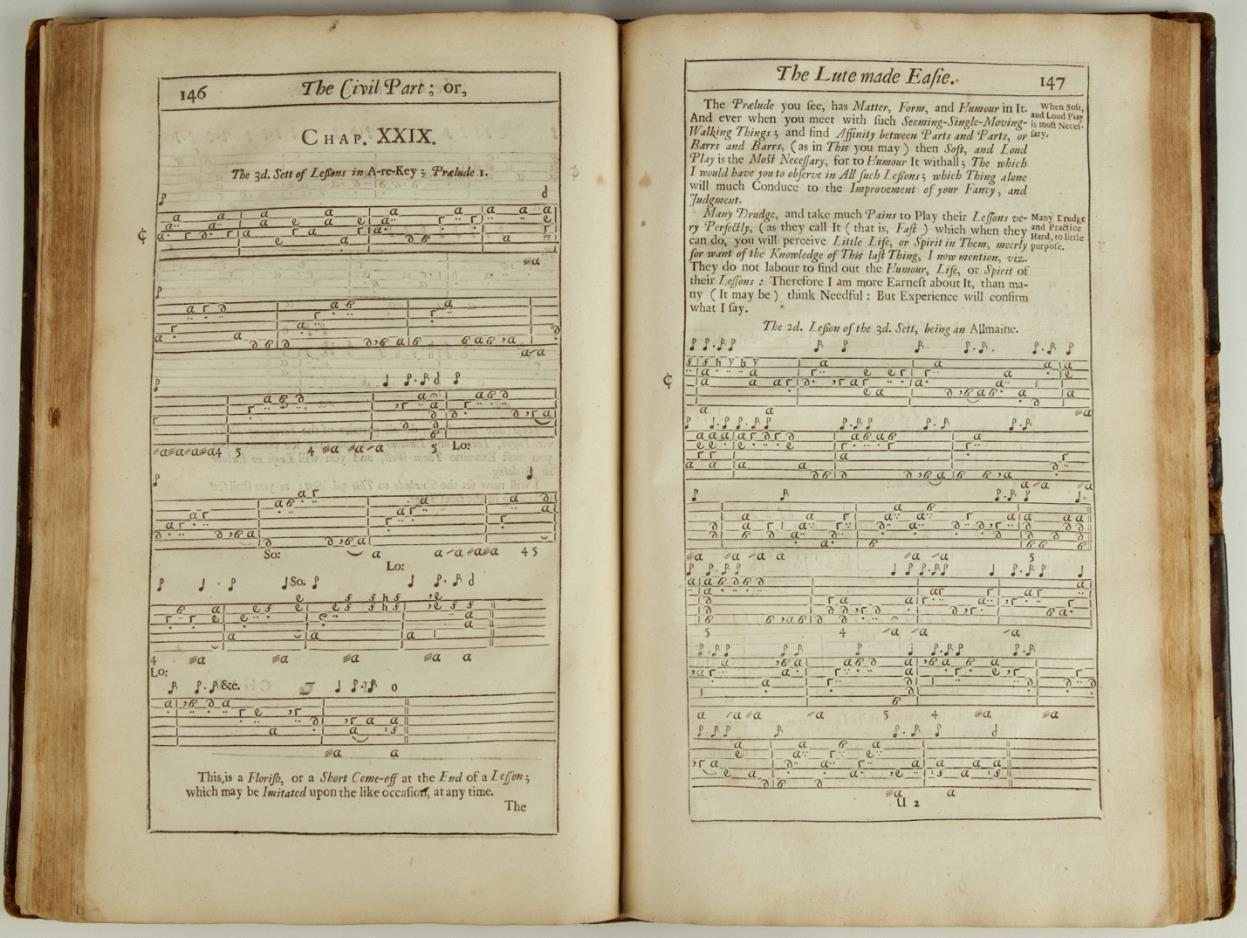
Provenance
From the library of the noted English early music specialist Arnold Dolmetsch (1858 1940), with his small handstamp ("Dolmetsch Library") to foot of verso of title.
First Edition. Gregory Bartlett I p. 160. Cortot p. 117. Hirsch I 334. Wolffheim I 793. RISM BVI pp. 523 524. With portrait in first state (distinguished by the use of "Clericus" instead of "Clerici" at foot).
This important source of information on music in England during the second and third quarters of the 17th century is written in a highly readable, idiosyncratic style, presented in three parts. The first discusses psalm singing and the music of the parochial and cathedral churches; the second, and major, part of the work is entitled The Lute made Easie, and discusses the choosing of an instrument, tuning, repairing, performing on, and composing for the lute, with extensive musical examples and works for performance in lute tablature; the third part concerns the viol and includes a discussion of performance practice of consort music.
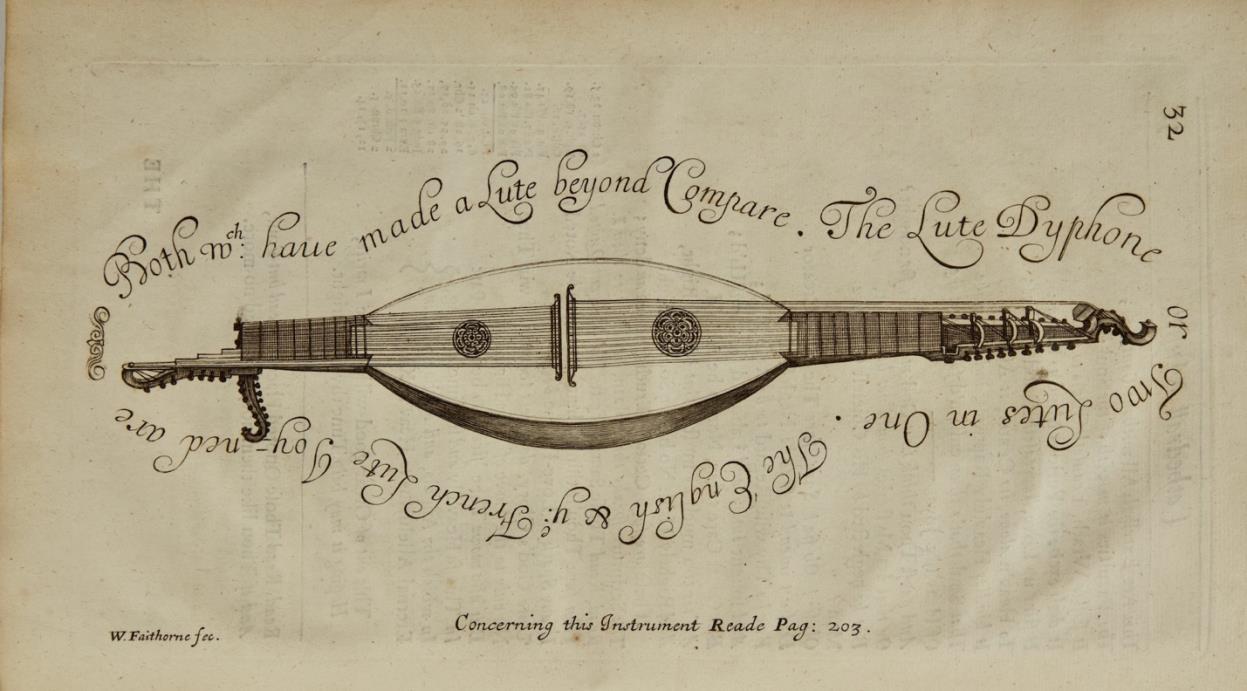
Dolmetsch was an "English instrument maker and pioneer in the revival of performances of early music on original instruments. ... [His] great gift was that, in a period when early music was virtually ignored except for academic study, he had both the imagination and the musicianship to take a musical work that had become a museum piece and to make it speak to the people of his own time in a language intelligible to them. He wrote the book The Interpretation of the Music of the XVII and XVIII Centuries " Margaret Campbell, revised by Katherine K. Preston in Grove Music Online
Quite a good copy of an important work, with distinguished provenance. (38594) $6,500
9. [MOZART]
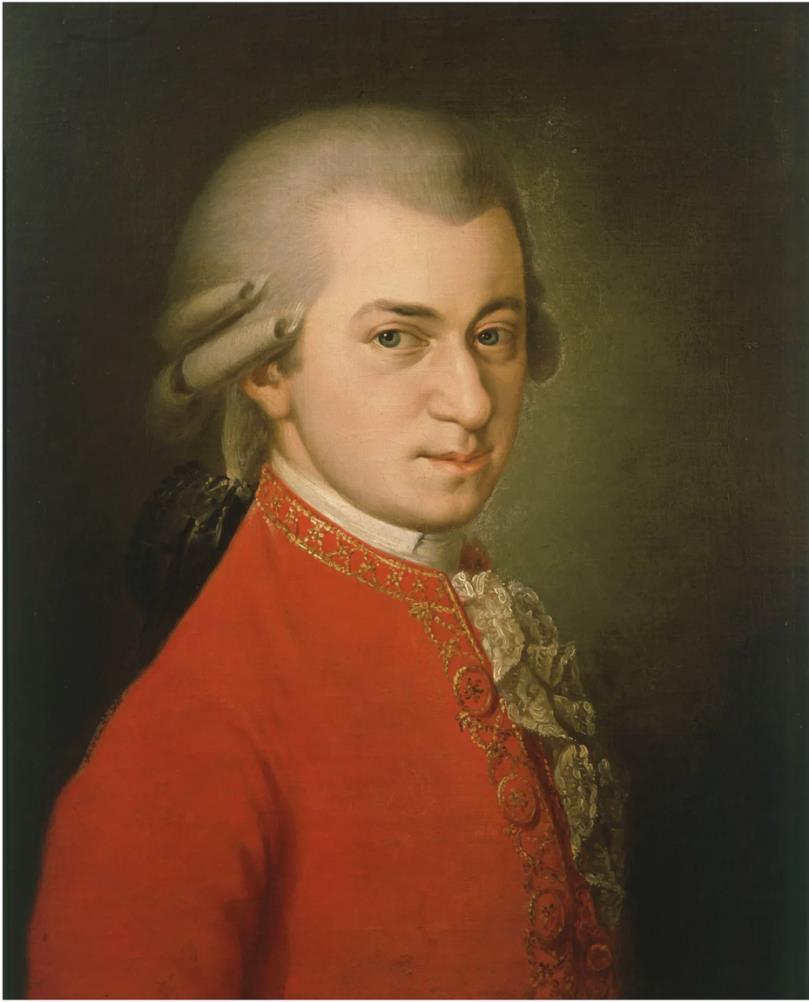
A collection of over 900 books, most dating from the 20th century but including some 19th century imprints; miscellaneous ephemera; a number of early and rare editions of Mozart's music; and several unique artifacts associated with the composer.
A singular opportunity to acquire the working library of one of the world's most distinguished Mozart scholars, The Mozart Research Collection of Professor Neal Zaslaw would be a notable acquisition for any institution or individual with a serious interest in Mozart studies.
is available upon request.
The Mozart Research Collection of Professor Neal Zaslaw10. PLAYFORD, John 1623 1686 or 1687
The Musical Companion, In Two Books. The First Book containing Catches and Rounds for Three Voyces. The Second Book containing Dialogues, Glees, Ayres and Songs for Two, Three and Four Voyces. Collected and Published by John Playford Practitioner in Musick. London: Printed by W. Godbid for John Playford, at his Shop in the Temple near the Church, 1673, 1672.
Small oblong quarto. Full modern dark brown mottled calf with double blind rules to edges of boards, black morocco label gilt with Dolmetsch Library shelfmark to foot of spine. Housed in a dark blue buckram clamshell box with printed paper label to spine, original contemporary leather boards preserved in a separate folder.
1f. (recto title, verso blank), [i] ("To all ingenuous Lovers of Musick" from "Their Wellwisher, John Playford"), [ii] ("To his Ingenuous Friend Mr. John Playford" from Cha. Pidgeon, Matthew Locke, and Tho. Jordan), [i] ("An Alphabetical Table of the Catches and Rounds contained in the First Part of this Book"), [ii] ("A Table for the Second Book, containing Dialogues, Glees, Ayres and Songs of Two, Three and Four Parts" and an "Advertisement relating to the First Book"), 1 58 pp., p. [59] (title to Part II: "The Musical Companion: Containing Dialogues, Glees, Ballads & Ayres, in several Varieties. Some for Two Three Four Voyces. The Second Part. London: Printed by W.G. for J. Playford, 1672"), pp. 60 223, with "Musick Books Printed and are to be Sold by John Playford" to verso of final leaf. Continuous pagination. Music typeset. Title page to Book I
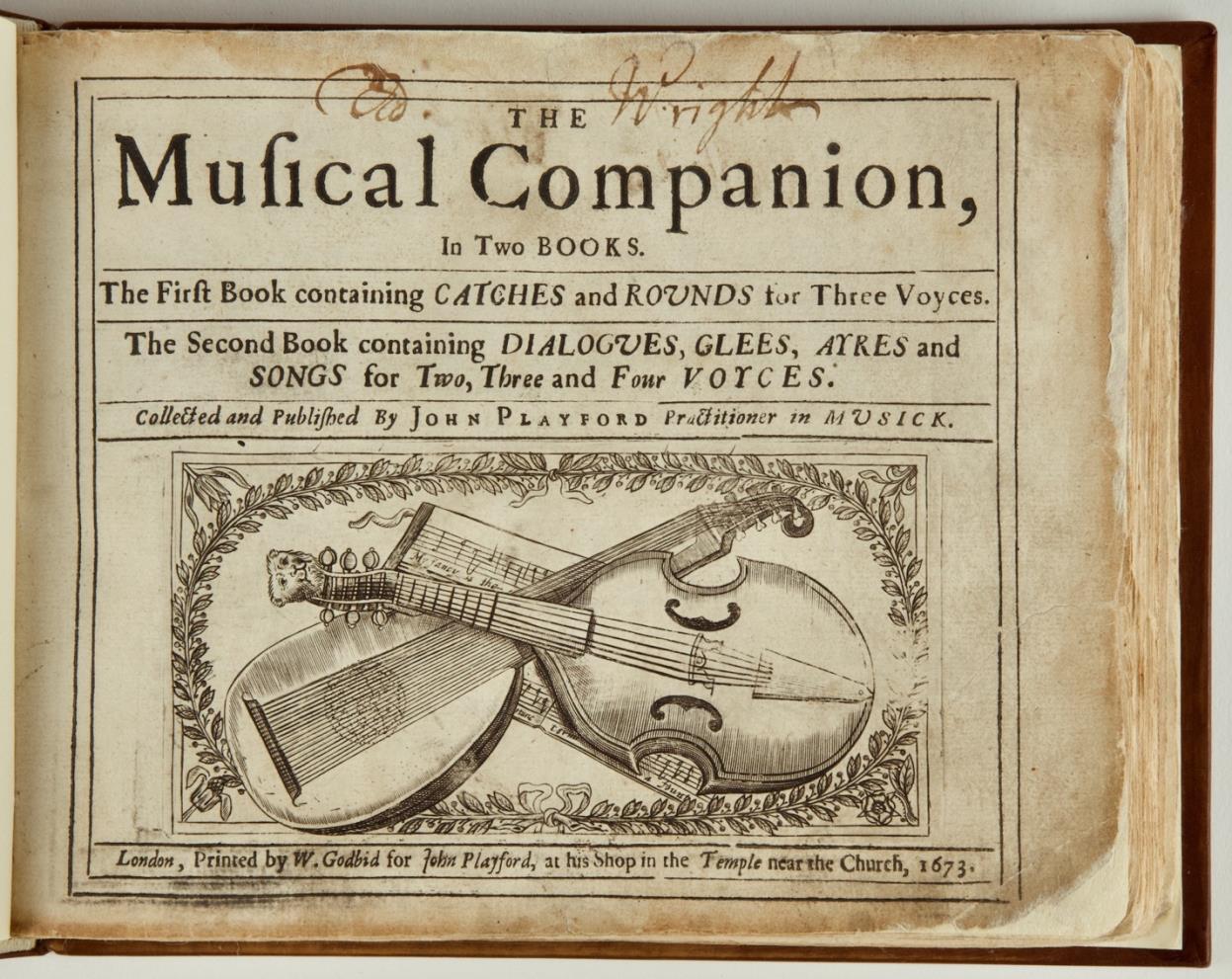
“To All Ingenuous Lovers of Musick”
with large engraved device of a crossed lute and viol, Book II with separate title page (dated 1672). Attractive decorative woodcut initials and headpieces throughout. With contemporary ownership signature ("Wright") to upper margin of title of Part I and early manuscript annotation to verso of rear endpaper: "O lead me to some backward Room / Where none by Jolly Drunkard Come." Early ink markings (crosses and turns) to heads of a number of pieces. Very slightly worn and browned; occasional small stains and signs of soiling; a few leaves very slightly trimmed, occasionally just touching text; outer margins of title to Part I, final leaf of Part II, and rear endpaper archivally repaired; very minor loss to blank corners of following two leaves; small hole to pp. 139/140; occasional minor defects.
Contains 210 songs and catches, with named composers including: J. Banister; William Bird [!Byrd]; Thomas Brewer; Campion; William Child; John Cobb; Edmund Coleman; Edward Coleman; Cranford; Deering; William Ellis; R. Fleckno; Orlando Gibbons; J. Goodgroome; William Gregorie; Roger Hill; John Hilton; Leno. Hodemonte; George Holmes; Thomas Holmes; Simon Ives; Jenkins; Rob. Johnson; N. Lanneare; Henry Lawes; William Lawes; Matthew Locke; Morley; Edmund Nelham; John Playford; Hen. Pursell[!Purcell]; Ben. Rogers; Jeremy Savile; Christopher Simpson; William Smegergill; John Smith; Stonerd; John Taylor; Syl. Taylor; Tho. Tempest; William Webb; Ben. Wellington; White; John Wilson; and Anon.
Provenance
From the library of the noted English early music specialist Arnold Dolmetsch (1858 1940), with his small handstamp ("Dolmetsch Library") to foot of verso of title of Part I. With conservator's label to lower pastedown dated 5 November 2002.
First Edition, [?]second issue. Day & Murrie 36. BUC p. 718. Title to Part I illustrated in Fraenkel: Pictorial and Decorative Title Pages, plate no. 103.
Playford distinguishesthe present issue in his prefatoryremarks addressed "To all Ingenuous Lovers of Musick": "The former Impression of this Book finding so general acceptance, hath encouraged me to adventure another Edition; in which I have made it my care not only to amend some defects which were in the last, but indeed almost to new Model the whole: First, by selecting out of it only such songs as were most approved of, and by adding a considerable number which were not Printed in that Book. Secondly, by placing all for Two Voyces together; next, those for Three; and lastly, those for Four. And thirdly, Printing the several Parts in such a Method as all may Sing by one Book. Lastly, the Songs for Two, Three and Four parts are all Printed in the G sol re ut Cliff, for the more convenient Singing either by Boys or Men ..."
Playford, a highly important English publisher, bookseller, minor composer, and vicar choral of St Paul’s Cathedral, is perhaps best known for his publication of The Dancing Master in 1651, significant both as a source of countrydancesand ofballadairs. A number ofhis originalcompositionsareincludedinthe presentcollection.
Dolmetsch was an "English instrument maker and pioneer in the revival of performances of early music on original instruments. ... [His] great gift was that, in a period when early music was virtually ignored except for academic study, he had both the imagination and the musicianship to take a musical work that had become a museum piece and to make it speak to the people of his own time in a language intelligible to them. He wrote the book The Interpretation of the Music of the XVII and XVIII Centuries …” Margaret Campbell, revised by Katherine K. Preston in Grove Music Online
A very good copy of an important work, with distinguished provenance. (38596) $9,500
11. RAVEL, Maurice 1875 1937
Inscribed by Ravel at the Premiere and by Pianist Marguerite Long
Concerto pour piano et orchestre. Inscribed by both Ravel and pianist Marguerite Long on the occasion of the world premiere of the work in Paris in 1932. [Full study score]. Paris: Durand & Cie [PN D. & F. 122150 to final leaf only], [1932].
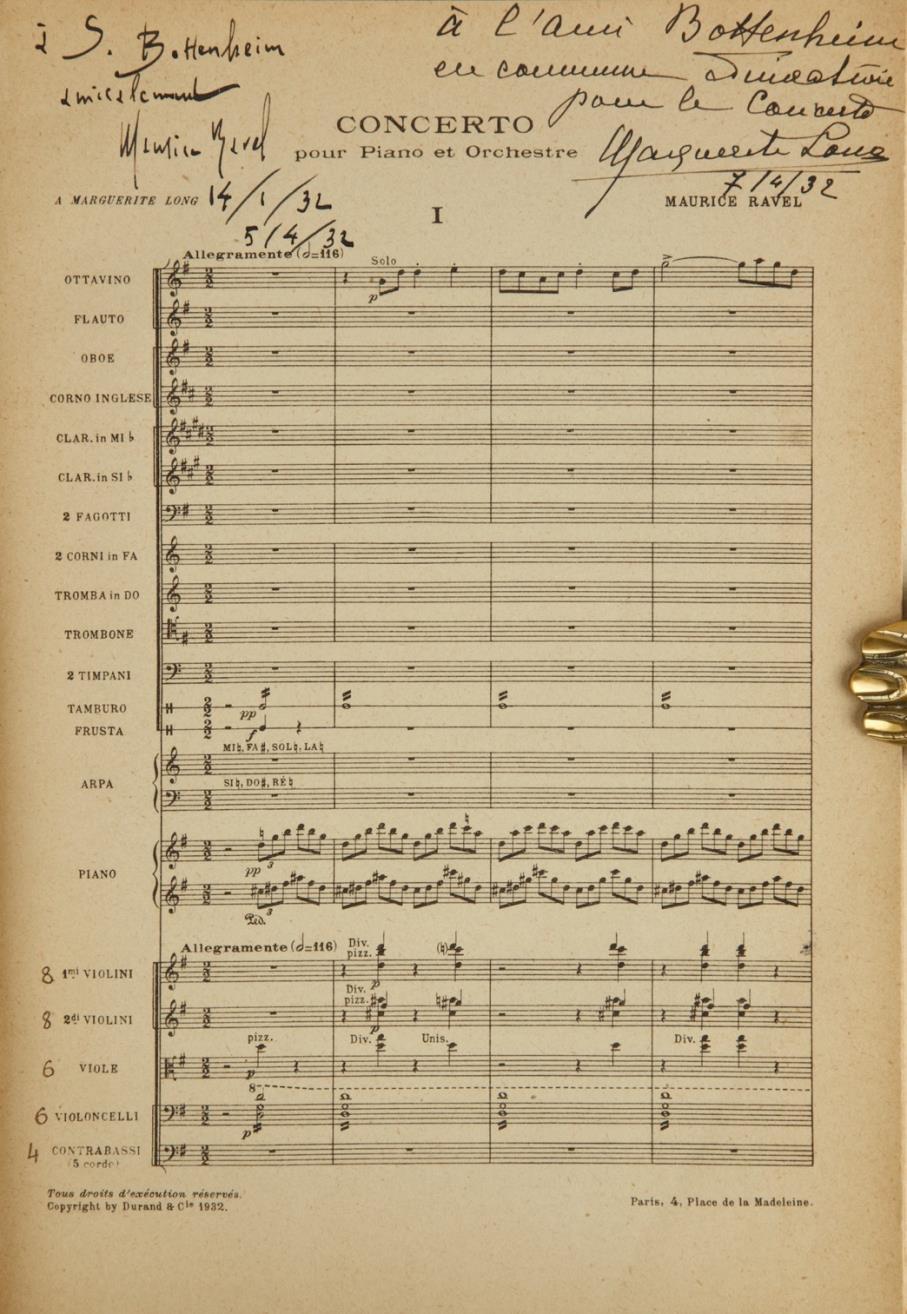
Octavo (22.2 cms.). Full light blue cloth. 1f. (recto title printed in red, verso blank), 1f. (blank), 1f. (recto instrument list and copyright notice, verso blank), [i] (blank), [i] (blank) pp. Browned; title and following four leaves very slightly creased at lower outer corner; lower portion of pp. 1 4 partially detached.
Inscribed in ink at head of first page of music by Ravel to Dutch impresario S. Bottenheim (with dates of both first and second performance of the work, 14 January 1932 and 5 April 1932) and by pianist Marguerite Long (7 April 1932), to whom Ravel dedicated the work and by whom the first two performances were given, with Ravel conducting.
With a manuscript list of subsequent performances in Haarlem, Amsterdam, the Hague, Paris, Utrecht, etc. to blank final leaf noting conductors and pianists performing, among them Ravel/Long, Mengelberg/Long, Van Goudoever/Long, van Beinum/Henriot, van Beinum/Casadesus, and Leonard Bernstein (no pianist noted), in all likelihood in Bottenheim's hand.
Price list to upper wrapper specifies a solo piano part with piano reduction of the orchestral parts (40 fr.), a version for two pianos, four hands (75 fr.), a full size score (200 fr.), a study score (40 fr.), parts and supplement (40 fr.). With "Ch. Douin, gr., Poinçons Durand & Cie." to lower right margin of p. 95 and "Imp. A. Mounot" to lower left.
First Edition in this form. Orenstein p. 240.
"Not only did Ravel plan to be the soloist in the G Major Concerto but he contemplated a world tour. ... Because of his declining health, he conducted the Concerto with Marguerite Long as soloist, and the projected tour was limited to Europe. In November, 1931, the manuscript was given to Madame Long and interpretative details were carefully worked out in the ensuing weeks. The première of the Concerto took place on January 14, 1932, at the Salle Pleyel as part of a Ravel festival. ... The evening was a brilliant success, and the critics were unanimous in their approbation of the Concerto, noting the brilliance of the first movement, the tender poetry of the second, and the dazzling verve of the finale." Orenstein: Ravel: Man and Musician, p. 102
"Although written 'in the spirit of Mozart and Saint Saëns,' passages in this concerto recall the work of Stravinsky and Gershwin, together with elements of Basque and Spanish music. ... The piano concerti contain Ravel's most successful adaptations of American jazz, and they reflect the spiritual fruit of the composer's trip to North America." ibid, pp. 204 205
Marguerite Long (1874 1966), a noted pianist and Ravel's long time friend, gave the first performance of his Le Tombeau de Couperin in1919, thefinal movement ofwhichhe dedicatedtoLong's husband Josephde Marliave, who died in action in August of 1914. Their relationship strengthened in 1932, when the two toured together with the Piano Concerto in G Major. Active in French musical circles from her early years, Long was the first woman granted full professorship at the Paris Conservatoire and enjoyed an extensive concert career, including to South America. She was a champion of French music, and came to be regarded as its ambassador.
A notable association copy (38759) $1,650
One of the Most Important Sources for the History and Construction of the Viola da Gamba
12 ROUSSEAU, Jean 1644 1699
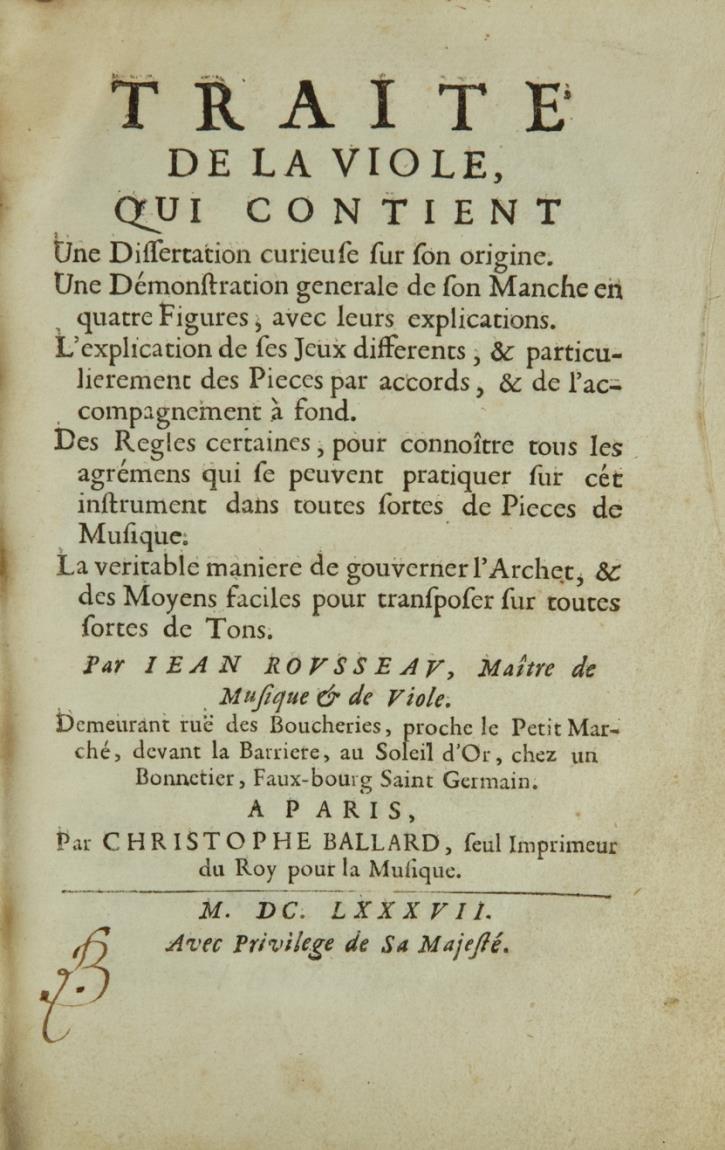
Traité de la Viole, qui contient Une Dissertation curieuse sur son origine. Une Démonstration generale de son Manche en quatre Figures, avec leurs explications. L'explication de ses Jeux differents, & particulierement des Pieces par accords, & de l'accompagnement à fond. Des Regles certaines, pour connoître tous les agrémens qui se peuvent pratiquer sur cét instrument dans toutes sortes de Pieces de Musique. Le veritable maniere de gouverner l'Archet, & des Moyens faciles pour transposer sur toutes sortes de Tons. Par Jean Rousseau, Maître de Musique & de Viole. Paris: Christophe Ballard, seul Imprimeur du Toy pour la Musique ... Avec Privilege de Sa Majesté, 1687.
Octavo. Full dark tan mottled calf with raised bands on spine in decorative compartments gilt, dark tan leather label titled in gilt, red speckled edges. 1f. (recto title, verso blank), [iii] (dedication to Monsieur de Sainte Colombe), iv ("Avant Propos" and "Remarques"), [iii] ("Table"), [ii] ("Extrait du Privilege du Roy"), [i] (errata), [i] (blank), 151, [i] (blank) pp. Decorative woodcut head and tailpieces and initials throughout. With typeset musical examples to pp. 120 151 consisting of "Modelles pour la Transposition d'un degré plus haut, & d'un degré plus bas; Modelles... d'une Tierce; and Modelles... d'une Quarte") and with additional numerous examples
of typeset music in text. Two narrow engraved folding plates: "Manche Harmonique" (277 x 81 mm.) between pp. 46 and 47 and "Manche pour la Tablature" between pp. 54 and 55 (ca. 278 x 87 mm.). Stylized "B" to blank lower inner margin of title (possibly Ballard's monogram) and manuscript paraph to foot of errata leaf (possibly that of Rousseau). Manuscript correction in pencil to pp. 121 and 123 (from "haut" to "bas"). Binding slightly, rubbed, and bumped; joints cracked; small portions of spine lacking; hinges tender; endpapers worn, browned, and soiled. Minor internal wear; edges slightly browned; light dampstaining to upper inner margins of several leaves and lower outer margins of several others; occasional small stains; pp. 31 32 slightly detached at head with small tear to blank inner margin repaired with archival tape; minor printer's error to pp. 145/146. Lacking two sections (the "Manche Diatonique" and "Manche Chromatic) of what was originally a larger single folding plate.
Provenance
From the library of the noted English early music specialist Arnold Dolmetsch (1858 1940), with his small handstamp ("Dolmetsch Library") to foot of verso of title.
First Edition. Cortot p. 170. Hirsch I, 513. Gregory Bartlett p. 237. Wolffheim 1162. RISM Écrits p. 720.
A distinguished French viol player, theorist, and composer, "Rousseau dedicated his Traité de la viole (1687) to Sainte Colombe and in it he defended his master's innovative approach to the position of the left hand one which facilitated performance in the melodic style (‘jeu de mélodie’) refuting point by point the attacks on unharmonized compositions made by Machy in the preface to his Pièces de violle (1685) ... The Traité also includes a discussion of the history of the viol in France which provides valuable information on construction techniques; Rousseau also mentions Thomas Young, Henry Butler and John Price and the influence of the English viol school on French musicians. The discussion of technique and bowing is the most thorough before Loulié, and in the discussion of ornamentation Rousseau draws upon the lute tradition as well as encouraging the adoption of conventions from vocal music." Robert A. Green in Grove Music Online
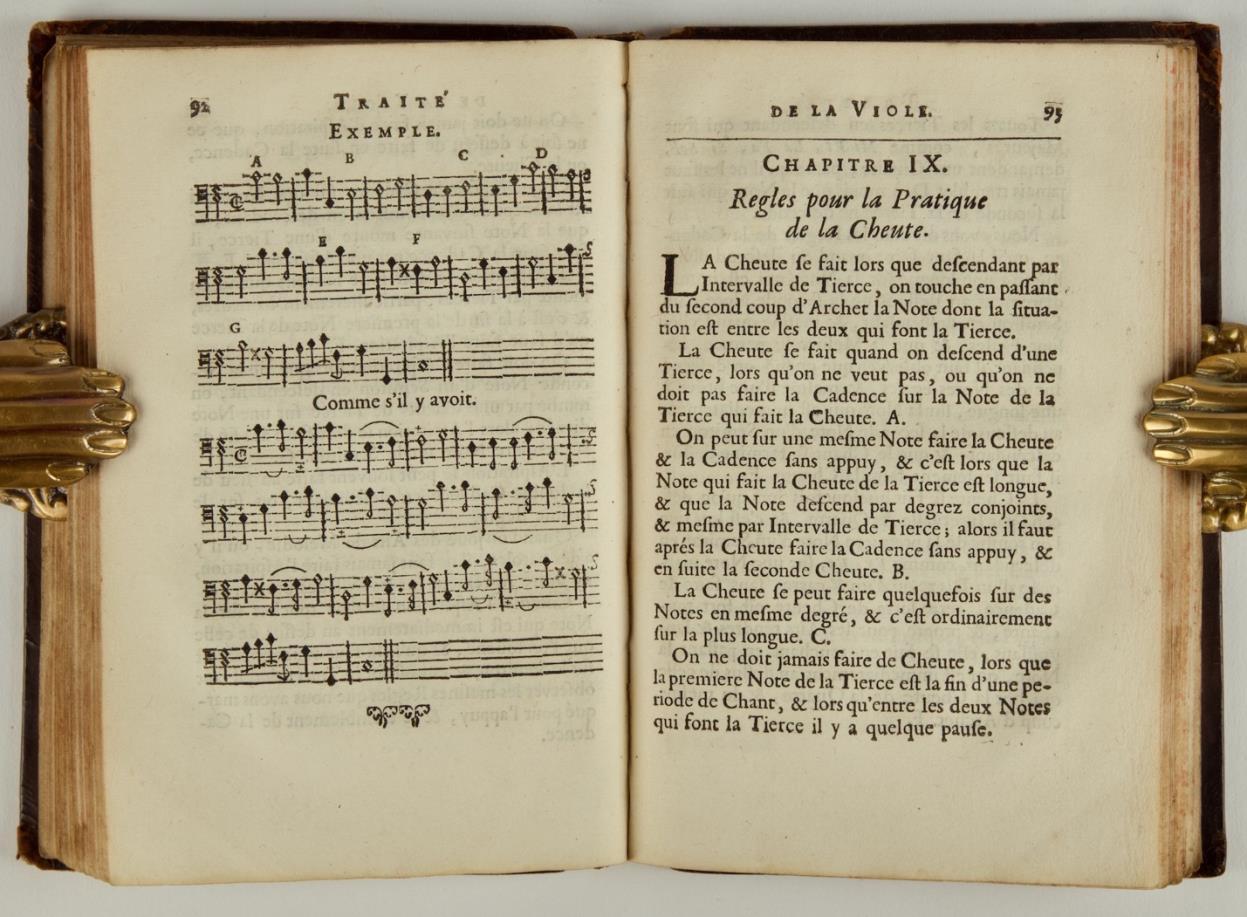
Dolmetsch was an "English instrument maker and pioneer in the revival of performances of early music on original instruments. ... [His] great gift was that, in a period when early music was virtually ignored except for academic study, he had both the imagination and the musicianship to take a musical work that had become a museum piece and to make it speak to the people of his own time in a language intelligible to them. He wrote the book The Interpretation of the Music of the XVII and XVIII Centuries …” Margaret Campbell, revised by Katherine K. Preston in Grove Music Online
important
70 Exquisitely Hand-Colored Aquatints by Alessandro Sanquirico, Sole Designer and Chief Scene Painter at La Scala, the Most Important Theatre in Milan, from 1817 to 1832

One of the Very Finest Illustrated Records of Opera and Ballet in Italy in the First Half of the 19th Century
13 SANQUIRICO, Alessandro 1777 1849
Raccolta Varie Decorazione Sceniche inventate, e dipinto dal Pittore Alessandro Sanquirico per l'I.R. Teatro della Scala in Milano. Bound with: Scene eseguite pel Melodramma serio L'ultimo giorno di Pompei inventate, e dipinte dal pittore Alessandro Sanquirico per l'I.R. Teatro della Scala in Milano. [Milano, ca. 1827].
Very large oblong folio (39.2 x 47 cms.). Contemporary dark red cross grained morocco gilt with decorative Greek key panels, thin serrated fillets, outer border with neo classical roundels, margins andinner dentelles with floral/leafy motif, flat spine in compartments with abstract star pattern gilt. 72 leaves in total. On Whatman Turkey Mill paper with watermarks 1824 and 1827, interleaved throughout with original tissue guards watermarked "FB." With a fine calligraphic manuscript title page to each part.
70 exquisitely hand colored aquatint plates in total, 69 of which illustrate Sanquirico's set designs for operas and ballets performed at La Scala from 1812 1827, the whole preceded by a fine neo Classical frontispiece.
OPERAS
33 plates of set designs for operas, listed by composer: Francesco Basily (1767 1850): Gli Illinsei Simon Mayr (1763 1845): La Fedra Saverio Mercadante (1795 1870): Amleto; Elisa e Claudio Giacomo Meyerbeer (1791 1864): Il Crociato in Egitto Francesco Morlacchi (1784 1841): Il Silenzio ed Il Mistero Giuseppe Mosca (1772 1839): La Sciocca; Emira (2) Wolfgang Amadeus Mozart (1756 1791): La Clemenza di Tito (3) Giovanni Pacini (1796 1867): L'ultimo giorno di Pompei (7); Gli Arabi Stefano Pavesi (1779 1850): La gioventù di Cesare (2) Gioachino Rossini (1792 1868): Semiramide; Ciro in Babilonia (2); La Gazza Ladra Carlo Soliva (1792 1853): Le Zingare dell' Asturia Peter Winter (1754 1825): Le due Valdomire (5); Maometto
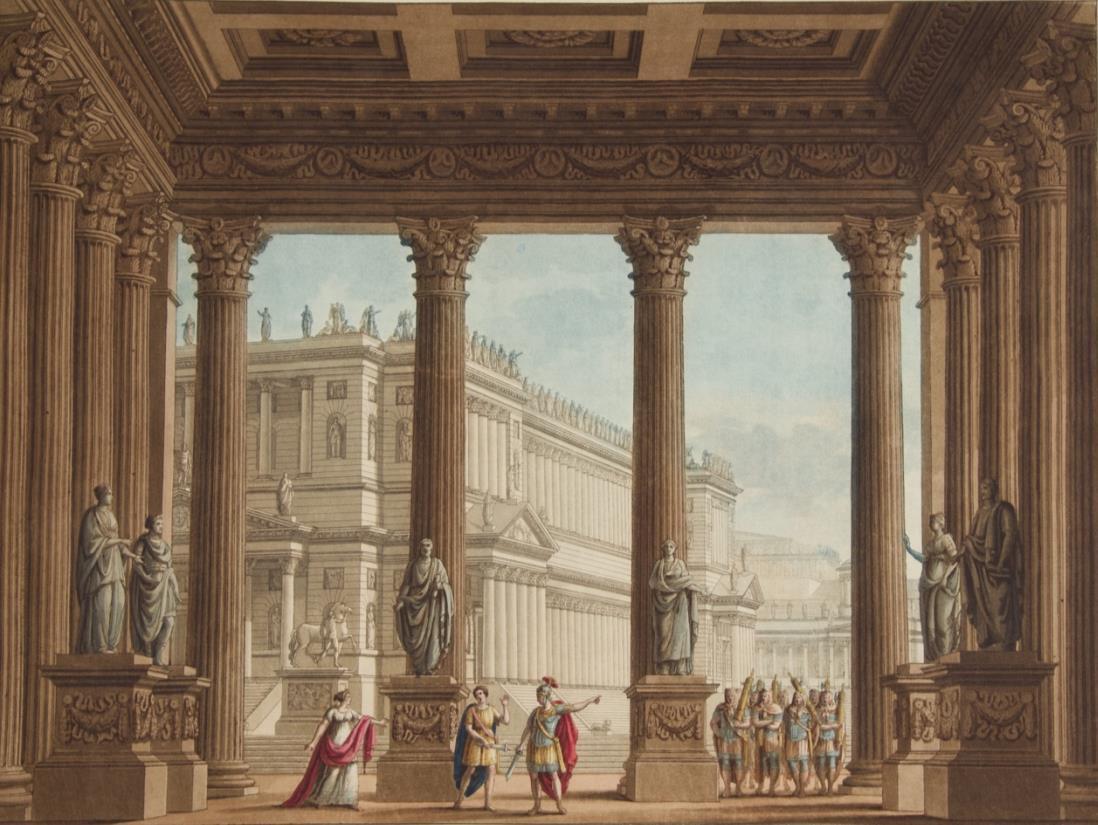
BALLETS
36 plates of set designs for ballets, listed by choreographer: Giovanni Aumer (1776 1833): Cleopatra in Tarso William Barrymore (1759 1830): Il Naufragio di La Peyrouse Francesco Clerico (?1755 after 1838): La Morte d'Ettore (2); Maometto (2); La presa di Babilonia Alessandro Fabbri (fl. 1800 1820): Ramesse Giovanni Galzerani (ca. 1789 after 1853): Maria Stuarda (2) Urbano Garzia (1786 1821): Il trionfo di Ciro Gaetano Gioja (1768 1826): Il Conte d'Essex; Arsinoe e Telemaco; Ottavia Luigi (Louis) Henry (1784 1836): Elerz e Zulnida Salvatore Taglioni (1789 1868): Sesostri Salvatore Viganò (1769 1821): La Vestale (3); La Spada di Kenneth; Psammi (3); Mirra (2); L'alunno della giumenta (2); Otello (2); Alessandro; I Titani; Bianca; Dedalo (2); Numa Pompilio; Gli Strelitzi
ENGRAVERS
Albertoli; Aluisetti; Angeli; Biasioli; Bonatti; Bramati; Castellini; Durelli; Carolina Lose (or Luose); Rados; Rainieri; Carlo Sanquirico; and C. Zucchi
CONTENTS, in orderof appearanceinthevolume, listed bycomposerfor operas andchoreographerfor ballets:
1 leaf calligraphic manuscript title: Scene eseguite pel Melodramma serio L'ultimo giorno di Pompei ...
1. Fine neo classical frontispiece
2. PACINI. Atrio della Casa di Salustio. Quests scena fu eseguita nel Melodramma serio L'ultimo giorno di Pompei, del. Sigr. Andrea Totola, posto in musica del Sigr. C. Pacini nell' I.R. Teatro della Scala. L'Autunno del 1827.
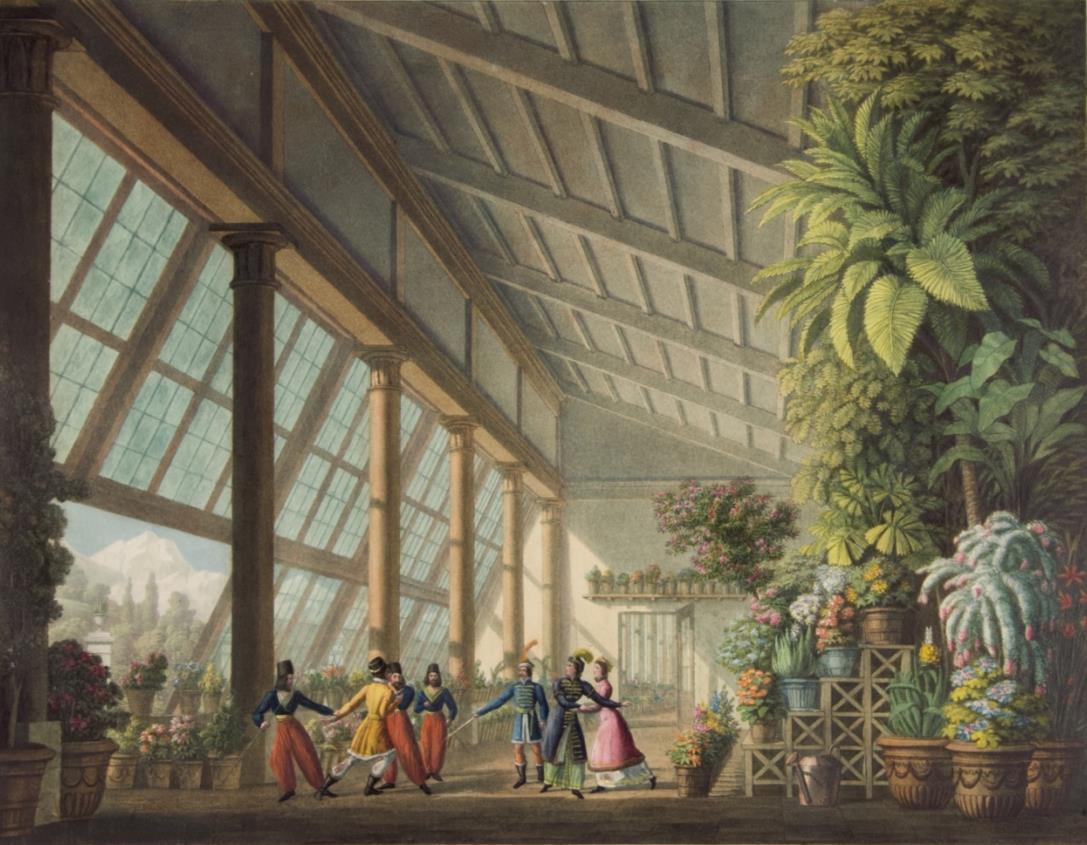
3. PACINI. Ingresso a Pompei della parte di Porta Nolana ... L'ultimo giorno di Pompei ... Engraved by Carlo Sanquirico.
4. PACINI. Foro di Pompei Festivamente Adorno ... L'ultimo giorno di Pompei ... Engraved by Angelo Biasioli.
5. PACINI. Interno della Basilica in Pompei ... L'ultimo giorno di Pompei ... Engraved by Aluisetti, aquatinted by Angeli.
6. PACINI. Ingresso all' Anfiteatro ... L'ultimo giorno di Pompei ... Engraved by Carlo Sanquirico.
7. PACINI. Giardino della Casa di Diomede presso alle Mura di Pompei ... L'ultimo giorno di Pompei.
8. PACINI. Sotterraneo Destinato al Supplizio de' Rei ... L'ultimo giorno di Pompei ... Engraved by Carlo Sanquirico.
1 leaf calligraphic manuscript title: Raccolta Varie Decorazione Sceniche
9. CLERICO. Tempio di Minerva. Questa scena fu eseguita pel Ballo tragico La Morte d'Ettore, inventato e posto sulle scene dell' I.R. Teatra alla Scala dal Sig. Francesco Clerico. La Primavera dell' Anno 1821. Engraved by Castellini. Music composed by Agostino Belloli (1778 1839).
10. GALZERANI. Camera. Scena eseguita pel Ballo tragico Maria Stuarda, composto dal Sig. Gio. Galzerani, nell' I.R. Teatro alla Scala in Milano. Il Carnevale dell' anno 1826. Engraved by Alessro. Angeli. Music composed by Francesco Vincenzo Schira (1809 1883).
11. MOSCA. Giardino. Questa scena fu eseguita pel Melodramma buffo La Sciocca per astuzia, del Sig. Luigi Romanelli, e posto in musica del Sig. Giuseppe Mosca nell' I.R. Teatro alla Scala La Primavera dell' Anno 1821. Engraved by C. Luose.
12. CLERICO. Tempio di Mecca. Questa scena fu eseguita pel Ballo tragico, Maometto, composo, e messo sulle scene dell' I.R Teatro alla Scala da Francesco Clerico. La Primavera dell' anno 1822. Musicarrangedbyvarious "celebrated composers" and arranged by Paolo Brambilla (1786 1838)
13. MEYERBEER. Porto di Damiata. Scene eseguita pel Melodramma eroico Il Crociato in Egitto, posto in musica dal Sig. Giacomo Mayerbeer[!] e rappresentato nell' I.R. Teatro alla Scala. La Quaresima dell' anno 1826

14. HENRY. Interno di una Serra. Questa scena fu esequita pel Ballo Mimico di carattere Elerz e Zulnida posto su le scene dell' I.R. Teatro alla Scala dal Sig. Luigi Henry. La Primavera dell' anno 1826. Engraved byCarolina Lose. Music composed by Cesare Pugni (1802 1870).
15. PACINI. Volte Sotterranee. Questa Scena fu eseguita pel Melodramma serio Gli Arabi nelle Gallie del Sig. Luigi Romanelli posto in musica dal Sig. Pacini nell I.R. Teatro alla Scala. La Quaresima dell' Anno 1827.
16. MERCADANTE. Luogo Destinato ai Sepolcri dei Re di Danimarca. Questa Scena fu eseguita pel Melodramma Tragico Amleto, del Sigr. Felice Romani, e posto in Musica dal Sigr. Saverio Mercadante, nell I.R. Teatro alla Scala. il Carnevale dell' anno 1823. Engraved by Castelini.
17. SOLIVA. Luogo Rimoto nel Parco d'un Castello nelle Montagne Dell' Asturia, Circondato da Alte Muraglie. Questa scena fu eseguita pel Melodramma serio Le Zingare dell' Asturia, del Sig. Felice Romani, posto in musica dal Sig. Carlo Soliva nell' I.R. Teatro alla Scala. L'Autunno dell' Anno 1817. Engraved by Carolina Lose.
18. VIGANO. Bosco Sacro contiguo al Collegio de' Flamini, ed al Tempio di Vesta. Questa scena fu eseguita pel Ballo tragico, La Vestale, composto dal Sig. Salvatore Viganò, e messo sulle scene dell' I.R. Teatro alla Scala. La Primavera dell' Anno 1818. Engraved by Carolina Lose. Composer unknown, but quite likely Viganò.
19. ROSSINI. Interno del Santuario. Questa Scena fu eseguita pel Melodramma tragico, la Semiramide con musica del Sig. Gioachimo[!] Rossini nell' I.R. Teatro alla Scala. La Primavera dell' Anno 1824. Engraved by Carlo Sanquirico.
20. VIGANÒ. Appartamento d'Elisabetta nella Scozia. Questa scena fu eseguita pel Ballo eroico, La Spada di Kenneth, inventato, e posto sulle scene del' I.R. Teatro alla Scala, dal Sig. Salvatore Viganò. la Primavera dell' Anno 1818. Engraved by A. Biasioli. Composer unknown, but quite likely Viganò.

21. WINTER. Carcere nel Castello di Danimarca. Questa scena fu eseguita pel Melodramma serio, Li due Valdomiri, del Sig. Felice Romani, posto in musica dal Sig. Pietro De Winter nell' I.R. Teatro alla Scala. Il Carnevale dell' anno 1818.
22. MAYR. Atrio che mette agli Appartamenti Reali. Questa scena fu eseguita pel Melodramma serie La Fedra, posto in musica dal Sig. Gio. Simone Maÿr nell' I.R. Teatro alla Scala. Engraved by G. Castellini.
23. VIGANÒ. Interno d'una Piramide Sepolcrale. Questa scena fu eseguita pel Ballo tragico Psammi, inventato dal Sig. Salvatore Viganò, posto sulle scene dell' I.R. Teatro alla Scala. L'Autunno dell' Anno 1817. Aquatinted by Biasioli. Composer unknown, but quite likely Viganò.
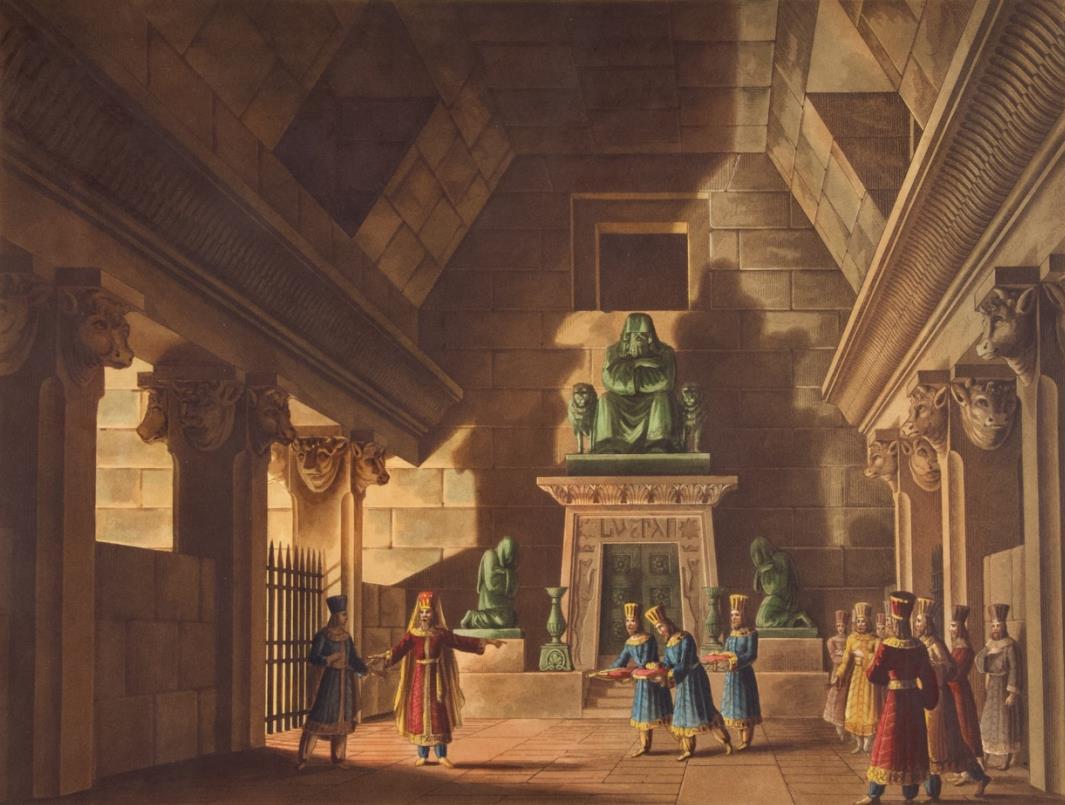
24. VIGANÒ. Ameno Boschetto con Tempio Consacrato a Venere. Questa scena fu eseguita pel Ballo mitologico, Mirra, ossia La Vendetta di Venere, inventato, e messo sulle scene dell' I.R. Teatro alla Scala dal Sig. Salvatore Viganò. Nella Primavera dell' Anno 1817. Engraved by Carolina Lose.
25. WINTER. Tempio sotterraneo. Questa Scena fu eseguita pel Melodramma tragico il Maometto, poesia del Sigr. Felice Romani e musica del Sigr. Pietro De Winter nell' I.R. Teatro alla Scala. Nel Carnevale dell' anno 1826. Engraved by Rainieri.
26. WINTER. Cortile nel Castello di Danimarca. Questa scena fu esequita pel Melodramma serio, Li due Valdomiri, del Sig. Felice Romani, posto in musica dal Sig. Pietro De Winter nell' I.R. Teatro alla Scala. Il Carnevale dell' Anno 1818.
27. PAVESI. Luogo Spazioso nell'Interno dell' Isola di Farmacusa dai Lati abitazi dei Corsali in Fondo Recinto degli Schiavi. Questa scena fu eseguita pel Melodramma eroicomico La Gioventù di Cesare, posto in musica
dal Sig. Stefano Pavesi, rappresentato nell' I.R. Teatro alla Scala. La Primavera dell' Anno 1817. Engraved by Carolina Luose.
28. ROSSINI. Reggia. Questa scena fu eseguita pel Melodramma serio, Ciro in Babilonia, posto ii musica dal Sig. maestro Giochimo[!] Rossini, e rappresento. nell' I.R. Teatro alla Scala il carenevale dell' anno 1818. Engraved by A. Biasioli.
29. GARZIA. Campo d'Astiage in Persia. Questa scena fu eseguita pel Ballo tragico, Il Trionfo di Ciro, inventato, e posto sulle scene dell' I.R. Teatro alla Scala dal Sig. Urbano Garzia. La Primavera dell' anno 1817 Engraved by Carolina Lose. Music composed by Agostino Belloli (1778 1839).
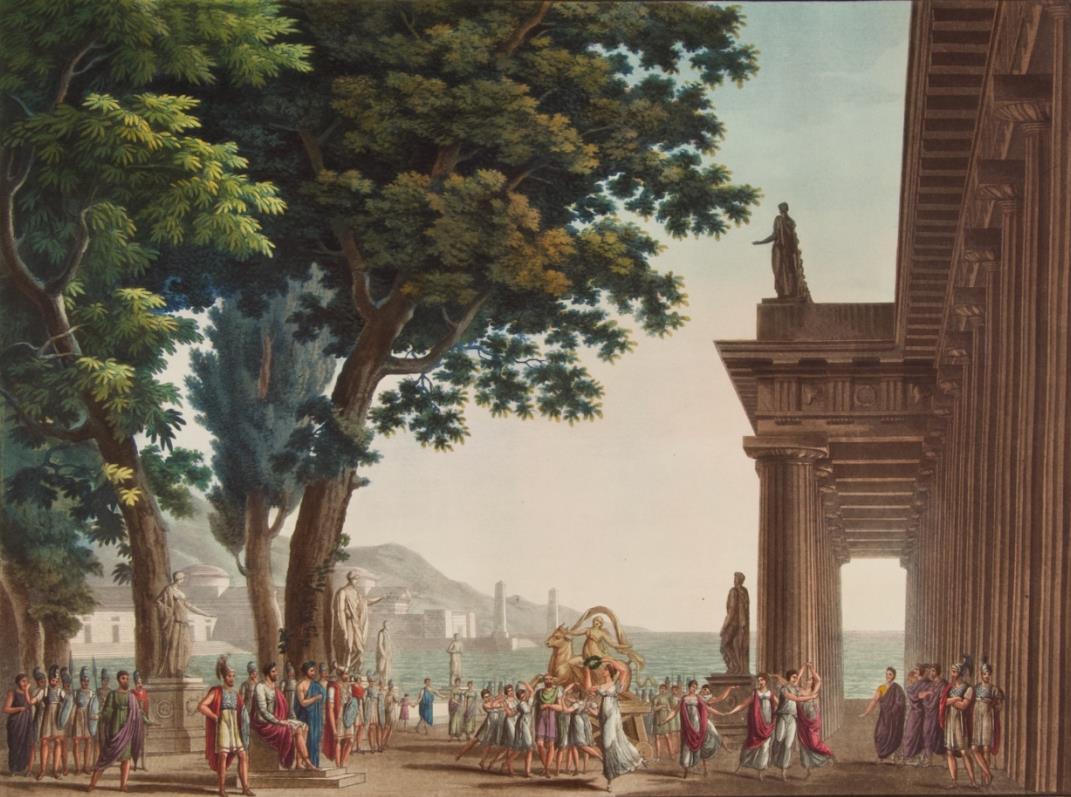
30. VIGANÒ. Rupi e Scoscesi Scogli che si Estendono sino al Mare Formando una Rada Capace di Vari Grossi Vascelli. Di Fianco si pre l'Ingresso ad una Vasta ed Oscura Spelonca. Questa scena fu eseguita pel Ballo tragico L'alunno della giumenta, ossia l'Ippotoo vendicato, composto e diretto dal Sig. Salvatore Viganò per l' I.R. Teatro alla Scala. La Priavera dell' Anno 1812. Engraved by Carolina Lose. Composer unknown, but quite likely Viganò.
31. VIGANÒ. Tempio di Giove. Questa scena fu eseguita pel Ballo mitologico, Mirra, ossia La vendetta di Venere, composto dal Sig. Salvatore Viganò per l' I.R. Teatro alla Scala. La Primavera dell' Anno 1817. Engraved by F. Albertoli. Composer unknown, but quite likely Viganò.
32. VIGANÒ. Gran Sala di Ballo nel Palazzo Ducale di Venezia. Questa scena fu eseguita pel Ballo tragico L'Otello, ossia il Moro di Venezia, inventato, e posto sulle scene dell' I.R. Teatro alla Scala del Sig. Salvatore Viganò. Il Carnevale dell' Anno 1818. Engraved by A. Biasioli. Music composed by Gioachino Rossini (1792 1868).
33. VIGANÒ. Giardino nel Palazzo d'Otello in Venezia. Questa scena fu eseguita pel Ballo tragico, Otello, ossia il Moro di Venezia, inventato, e posto sulle scene dell' I.R. Teatro alla Scala dal Sig. Salvatore Viganò. Il Carnevale dell' Anno 1818. Engraved by Carolina Lose.
34. ROSSINI. Tribunale del Podestà in un Grosso Villaggio non Molto Distante da Parigi. Questa scena fu eseguita pel Melodramma La Gazza Ladra, posto in musica dal Sig. Gioachimo[!] Rossini, e rappresentato nell' I.R. Teatro alla Scala. La Primavera dell' Anno 1817. Engraved by A. Biasioli.
35. VIGANÒ. Orti Pensili con Bagni in Memfi. Questa scena fu eseguita pel Ballo tragico Psammi, inventato dal Sig. Salvatore Viganò l'autunno dell' anno 1817, per l'I.R. Teatro alla scala. Engraved by Carolina Luose. Composer unknown, but quite likely Viganò.
36. MOZART. Portici in Vicinanza del Campidoglio. Questa Scena su eseguita pel Melodramma serio La Clemenza di Tito, messo in musica dal cele. maestro Sigr. Amadeo Mozzart[!], e posto sulle scene dell' I.R. Teatro alla Scala in Milano. Il Carnevale dell' anno 1819. Engraved by Rainieri.
37. ROSSINI. Prigione Sotterranea. Questa scena fu eseguita pel Melodramma serio, Ciro in Babilonia, posto in musica da Gioachimo[!] Rossini, rappresentato nell' I.R. Teatro alla Scala. Il Carnevale dell' Anno 1818.
38. VIGANÒ. Padiglione d'Alessandro. Questa scena fu eseguita pel Ballo Eroico Alessandro nell' Indie inventato e posto sulle scene dell' I.R. Teatro alla Scala dal Sigr. Salvatore Viganò nella Quaresima dell' Anno 1820. Engraved by Giuseppe Castellini. Music by various composers arranged by Paolo Brambilla (1786 1838) and Pietro Lichtenthal (1780 1853).

39. CLERICO. Appartamenti Reali. Questa Scena fu eseguita pel Ballo Tragico La Morte di Ettore, posto sulle scene dell' I.R. Teatro alla Scala dal Sigr. Francesco Clerico. La Primavera dell' anno 1821. Engraved by Rainieri. Music composed by Agostino Belloli (1778 1839).
40. VIGANÒ. Luogo Delizioso. Questa scena fu dipinta pel Ballo mitologico I Titani, inventato e posto sulle scene dell' I.R. Teatro alla Scala dal Sig. Salvatore Viganò. Il Carnevale dell' Anno 1818. Engraved by Carolina Lose. Composer unknown, but quite likely Viganò. This performance not recorded in Gatti, where only the 2 February 1820 performance is cited.
41. AUMER. Interno del Palazzo di Cleopatra. Questa scena venne eseguita pel Ballo istorico, Cleopatra in Tarso, inventato, e posto sulle scene dell' I.R. Teatro alla Scala dal Sig. Giovanni Aumer. Il Carnevale dell' Anno 1822. Engraved by L. Castellini. Composer unknown.

42. BASILY. Recinto presso le Abitazioni degli Illinesi. Questa scena fu eseguita pel Melodramma serio Gli Illinsei, composto dal Sig. Felice Romani, posto in musica dal Sig. Francesco Basily nell' I.R. Teatro alla Scala il Carnevale dell' Anno 1819. Engraved by [?]A. K. Bonatti. Gatti cites Johann Kaspar Aiblinger (?1788 1867) as the composer.
43. VIGANÒ. Sala nell' Appartamento di Ruggiero Re di Sicilia. Questa Scena fu eseguita pel Ballo Eroico Storico Bianca, o sia il Perdono per sorpresa, del Sigr. Salvatore Viganò, posto sulle scene dell' I.R. Teatro alla Scala. La Primavera dell' Anno 1819. Engraved by Bramati.
44. VIGANÒ. Giardino nella Reggia di Minosse nell' Isola di Creta. Questa scena fu eseguita pel Ballo mitologico, Dedalo, inventato, e posto sulle scene dell' I.R. Teatro alla Scala dal Sig. Salvatore Viganò. Il
Carnevale dell' Anno 1818. Engraved by Carolina Luose. Music mostly by Pietro Lichtenthal (1780 1853) but also including music by Haydn, Mozart, Rossini, and Umlauf.
45. WINTER. Atrio Interno in un Castello. Questa scena fu dipinta pel Melodramma serio I due Valdomiri, del Sig. Felice Romani, posto in musica dal Sig. Pietro De Winter nell' I.R. Teatro alla Scala. Il Carnevale dell' Anno 1818. Engraved by Carolina Luose.
46. BARRYMORE. Esterno di una Capanna. Questa Scena fu eseguita pel Ballo Pantomimo serio Il Naufragio di La Peyrouse, posto sulle scene dell' I.R. Teatro alla Canobbiana, dal Sigr. William Barrymore. L'Autuno[!] dell' anno 1825. Engraved by Carolina Lose. Music by Michael William Balfe (1808 1870).
47. VIGANÒ. Appartamenti d'Ersilia. Questa scena fu eseguita pel Ballo eroico favoloso, Numa Pompilio, inventato, e posto sulle scene dell' I.R. Teatro alla Scala dal Sig. Salvatore Viganò. Nella Quaresima dell' Anno 1815. Engraved by A. Biasioli. Composer unknown, but quite likely Viganò
48. PAVESI. Stanza con una Specie d'Arcova, sul Davanti Soffà con Tavolino, Lumi, Sedie ecc. Questa scena fu eseguita pel Melodramma eroicomico, La Gioventù di Cesare, posto in musica dal Sig. Stefano Pavesi, e rappresentato nell' I.R. Teatro alla Scala. La Primavera dell' Anno 1817. Engraved by A. Biasioli.
49. MERCADANTE. Sotteraneo. Questa scena fu eseguita pel Melodramma Semiserio, Elisa e Claudio, del Sig. Luigi Romanelli, posto in musica dal maestro Sig. Saverio Mercadante, nell' I.R. Teatro alla Scala nell' Autunno dell' Anno 1821. Engraved by L. Rados.
50. MORLACCHI. Sotterraneo con due Statue rappresentanti Il Silenzio ed Il Mistero. Questa scena fu eseguita pel Melodramma serio Le Danaidi, posto in music dal Sig. Franc Morlacchi, nell' I.R. Teatro alla Scala. La Quaresima dell' Anno 1819. Engraved by G. Alluisetti.
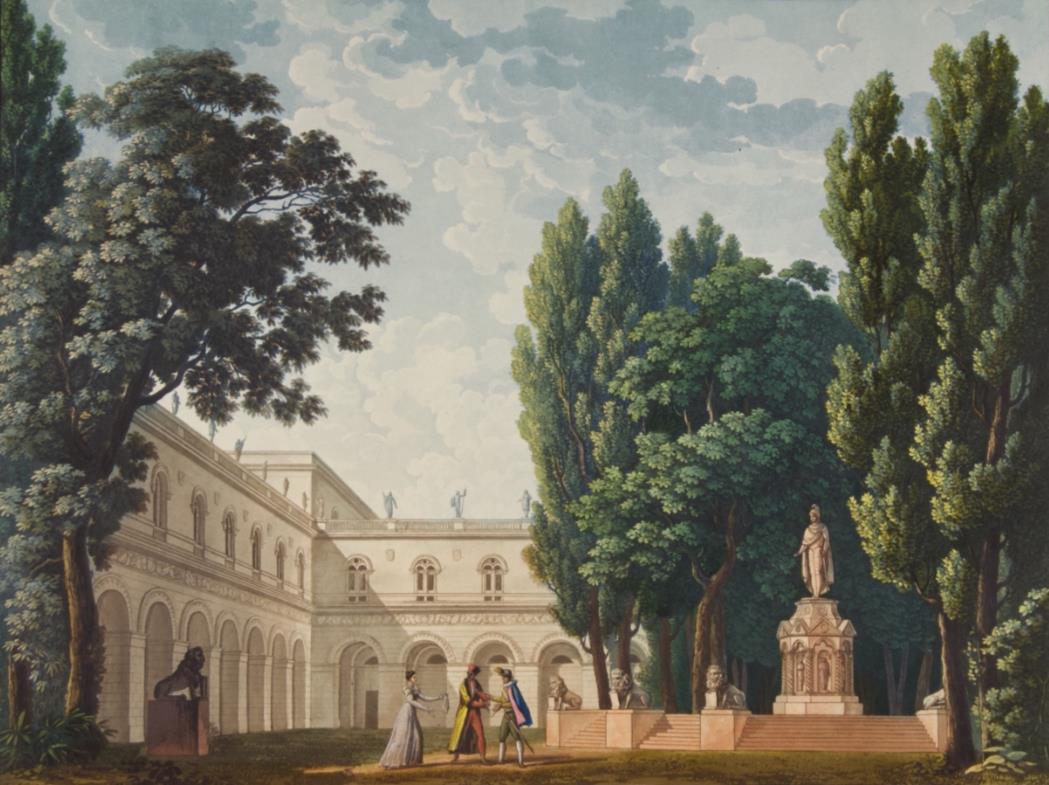
51. GIOJA. Appartamento d'una Regina. Questa scene fu eseguita pel Ballo eroico, Il Conte d'Essex, inventato, e posto sulle scene dell' I.R. Teatro alla Scala dal Sig. Gaetano Gioja. Nell' Autunno dell' Anno 1818. Engraved by C. Zucchi. Music mostly by Pietro Lichtenthal (1780 1853) but also including music by Beethoven, Cherubini, Haydn, and Rossini.
52. MOZART. Atrio del Tempio di Giove Statore. Questa scena venne eseguita pel Melodramma serio, La Clemenza di Tito, posto in musica dal Sig. Amadeo Mozart, nell' I.R. Teatro alla Scala. Il Carnevale dell' Anno 1819. Engraved by Durelli.
53. VIGANÒ. Luogo Interno nel Quartiere degli Strelitzi Notte. Questa scena fu eseguita pel quarto atto del Ballo eroico mimico Gli Strelitzi, inventato e diretto dal Sig. Salvate. Viganò, posto sulle scene dell' I.R. Teatro alla Scala il Carnevale dell' Anno 1812. Engraved by A. Biasioli. Composer unknown, but quite likely Viganò.
54. VIGANÒ. Appartamento nella Casa del Console Murena. Questa scena venne eseguita pel Ballo tragico, La Vestale, composto, e posto sulle scene dell' I.R. Teatro alla Scala dal Sig. Salvatore Viganò. Nella Primavera dell' Anno 1818. Engraved by G. Durelli. Composer unknown, but quite likely Viganò.

55. WINTER. Atrio Interno d'un Castello della Danimarca. Questa scena fu eseguita pel Melodramma serio I due Valdomiri, del Sig. Felice Romani, posto in musica dal Sig. Pietro de Winter nell' I.R. Teatro alla Scala il Carnevale dell' Anno 1818. Engraved by G. Castellini.
56. GALZERANI. Atrio nel Castello di Fotheringay. Scena eseguita pel Ballo tragico Maria Stuarda inventato dal Sigr. Giovanni Galzerani e posto sulle scena dell' I.R. Teatro alla Scala. Il Carnevale dell' Anno 1826. Engraved by Raineri. Music composed by Francesco Vincenzo Schira (1809 1853).
57. CLERICO. Tempio Sotterraneo. Questa scena fu eseguita pel Ballo tragico Maometto, inventato e posto sulle scene dell' I.R. Teatro alla Scala dal Sig. Franc. Clerico. La Primavera dell' Anno 1822. Engraved by L. Castellini. Music composed by Paolo Brambilla (1786 1838) and other unnamed composers.
58. FABBRI. Atrio Interno. Questa scena fu eseguita pel Ballo eroico Ramesse, ossia gli Arabi in Egitto, inventato e posto sulle scene dell' I.R. Teatro alla Scala da Alessan. Fabbri. La Primavera dell' Anno 1819. Engraved by G. Castellini. Music partially composed by Ferdinando Pontelibero (? 1829) with the remainder by other unnamed composers.
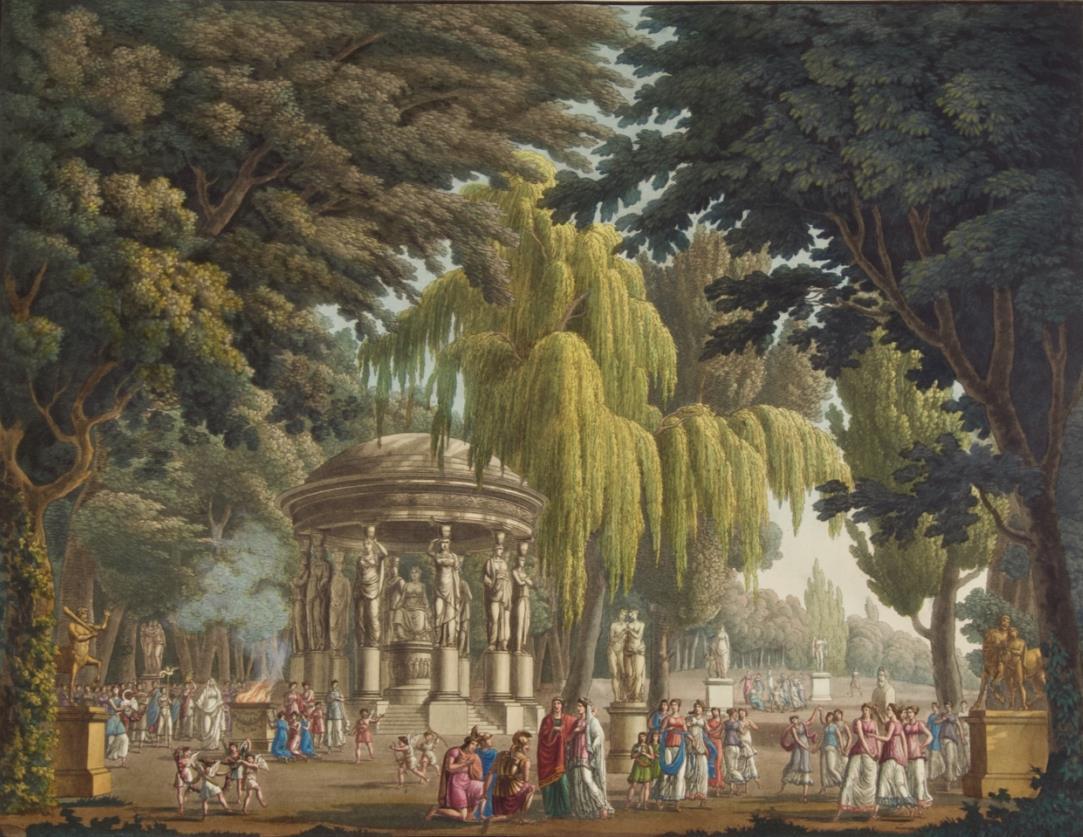
59. VIGANÒ. Atrio Contiguo alla Reggia di Ceruone. Questa scena fu eseguita pel Ballo tragico L'Alunno della Giumenta, ossia Ippotoo vendicato, composto, e messo sulle scena dell' I.R. Teatro alla Scala da Salvatore Viganò. La Primavera dell' Anno 1812. Composer unknown, but quite likely Viganò.
60. WINTER. Sala in un Castello della Danimarca. Questa scena fu eseguita pel Melodramma serio I due Valdomiri, del Sig. Felici Romani, posto in musica dal Sig. Pietro de Winter nell' I.R. Teatro alla Scala il Carnevale dell' Anno 1818. Engraved and aquatinted by A. Biasioli.
61. MOZART. Camera nella Reggia di Tito. Questa scena fu eseguita pel Melodramma serio, La Clemenza di Tito, con musica del Sig. Amadeo Mozart nell' I.R. Teatro alla Scala. Il Carnevale dell' Anno 1819. Engraved by G. Castellini.
62. VIGANÒ. Sala nella Reggia di Memfi. Questa scena fu eseguita pel Ballo tragico, Psammi, inventato, e posto sulle scene dell' I.R. Teatro alla Scala dal Sig. Salvatore Viganò. L'Autunno dell' Anno 1817. Engraved by G. Castellini. Composer unknown, but quite likely Viganò.
63. GIOJA. Atrio nella Reggia d'Ulisse. Questa scena fu eseguita pel Ballo eroico Arsinoe e Telemaco, inventato dal Sig. Gaetano Gioja e posto sulle scene dell' I.R. Teatro alla Scala il Carnevale dell' Anno 1814. Engraved by A. Biasioli. Music by Robert Graf von Gallenberg (1783 1839).
64. MOSCA. Sala del Consiglio nel Palazzo Reale. Questa scena fu eseguita pel Melodramma serio Emira, posto in musica dal Sig. maestro G. Mosca nell' I.R. Teatro alla Scala. Il Carnevale dell' Anno 1821. Engraved by C. Castellini.

65. CLERICO. Camera del Re Rischiarata da un Lume. Trono Situato di Fianco. Questa scena venne eseguita pel Ballo tragico, La presa di Babilonia, composto, e messo sulle scene dell' I.R. Teatro alla Scala dal Sig. Francesco Clerico. Nella Primavera dell' Anno 1821. Engraved by G. Castellini. Music by various "celebrated" unnamed composers.
66. MOSCA. Abbitazioni Interne delle Sacerdotesse. Questa scena fu eseguita pel Melodramma serio, Emira Regina d'Egitto, posto in musica dal Sig. maestro G. Mosca nell' I.R. Teatro alla Scala. Nel Carnevale dell' Anno 1821. Engraved by L. Castellini.
67. VIGANÒ. Atrio. Di Notte. Questa scena fu eseguita pel Ballo mitologico, Il Dedalo, inventate, e posto sulle scene dell' I.R. Teatro alla Scala dal Sig. Salvatore Viganò. Il Carnevale dell' Anno 1818. Engraved by A. Biasioli. Composer unknown, but quite likely Viganò.
68. GIOJA. Luogo Delizioso Contiguo alla Regia. Questa Scena fu eseguita pel Ballo Tragico Ottavia, composto dal Sigr. Gaetano Gioja, e posto sulle scene dell' I.R. Teatro alla Scala. Il Carnevale dell' anno 1823. Engraved by Carolina Lose. Music composed by Pietro Romani (1791 1877).
69. VIGANÒ. Tempio di Vesta; col Simulacro della Dea, dinanzi alla quale arde Il Fuoco Sacro. Questa scene fu eseguita pel Ballo tragico, La Vestale, inventato, e posto sulle scene dell' I.R. Teatro alla Scala dal Sig. Salvatore Viganò. Nella Primavera dell' Anno 1818. Engraved by G. Castellani. Composer unknown, but quite likely Viganò.
70. TAGLIONI. Stanze Sotterranee dov'erano custoditi il Tesori Reali. Scena eseguita pel Ballo grande = Sesostri = inventato, e posto sulle Scene dell' I.R. Teatro alla Scala, dal Sigr. Salvatore Tagliioni. L'Autunno dell' anno 1824. Engraved by C. Sanquirico. Music composed by Luigi Carlini (before 1800 after 1835).
Binding slightly worn, scratched, rubbed, and bumped; endpapers slightly worn, soiled, creased, and browned. Tissue guards creased, some slightly foxed or browned, some with small tears and resultant minor loss. Very minor signs of wear, soiling, staining, and foxing, primarily confined to margins; small tears to blank lower margin of plates 7, 38, 48 (repaired on verso), and 63; portions of legend to plate 23 faint; minor remnants of French bookseller's description, late 19th or early 20thcentury, to upper outercorner of front pastedown. In very good condition overall.
Sanquirico was the sole designer and chief scene painter at La Scala, the most important theatre in Milan, from 1817 to 1832
"From this powerful position during a rich period of operatic output, he influenced design standards for the works of Bellini, Donizetti, Mozart, Meyerbeer, Rossini and many other later composers until well into the 20th century. Among the hundreds of operas and ballets he designed at La Scala were the premières of Rossini’s La gazza ladra (1817), Bellini’s Norma (1831) and Donizetti’s Lucrezia Borgia (1833). Sanquirico’s designs were the foundation of the style commonly associated with 19th century grand opera. They combined the restrained neo classicism of his early training with the romantic trait of basing stage fantasy on historical accuracy and
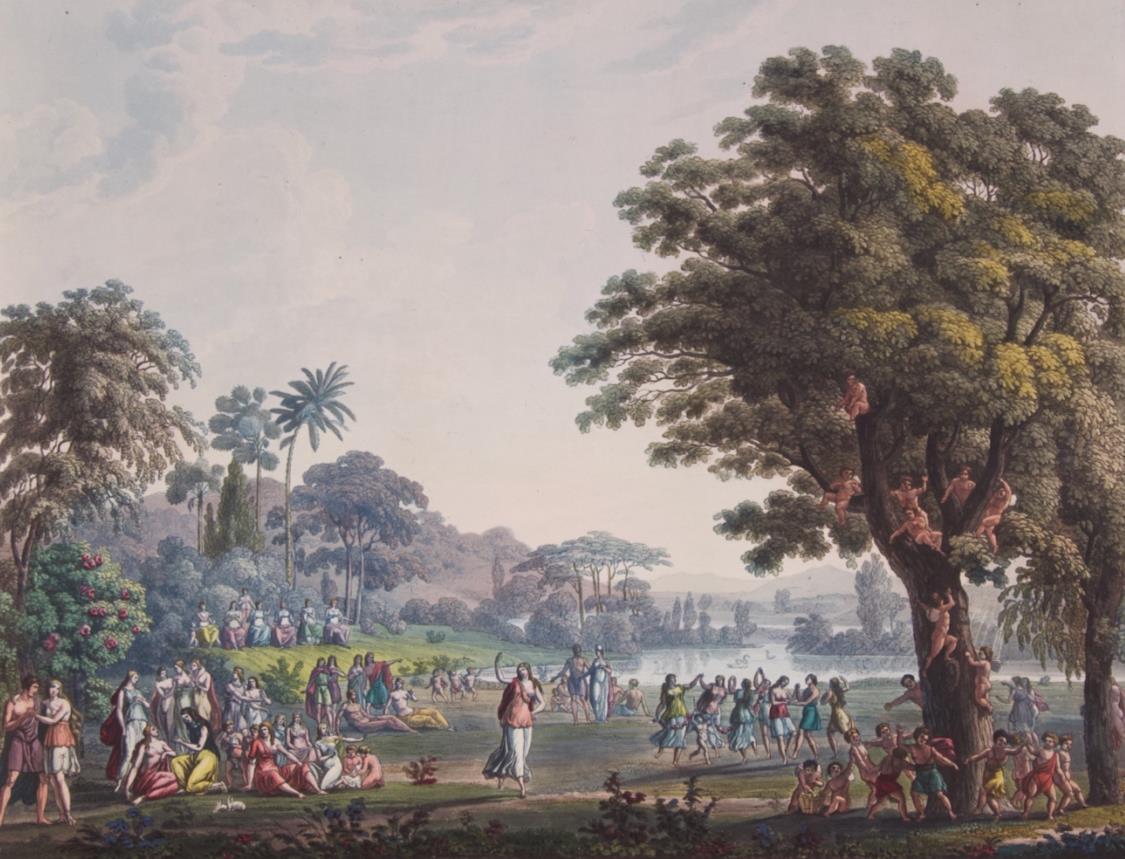
sensibility. ... A typical Sanquirico formula, widely copied and still theoretically valid, was to set a scene in a richly decorated architectural foreground which opened out on to a broad landscape view painted on a backdrop, profound in its simplicity. ... This solved many technical problems of scale and, at the same time, satisfied the aesthetic needs of romantic audiences for spectacle. The end of his career saw the introduction of gas lighting in theatres, and his painted scenery showed a sensitivity to the nuances of light which later scene painters lost because of advances in lighting control." Paul Sheren in Grove Music Online
"[Sanquirico] achieved dramatic effects by radical foreshortening of the architectural elements, and he heightened some of his designs by creating luminous central areas. His drops for I Titani, for example, are reminiscent of the paintings of Claude Lorrain and Nicolas Poussin, both in the tonality of their palettes and in their lighting effects." Reynolds: International Encyclopedia of Dance Vol. 5, p. 517.
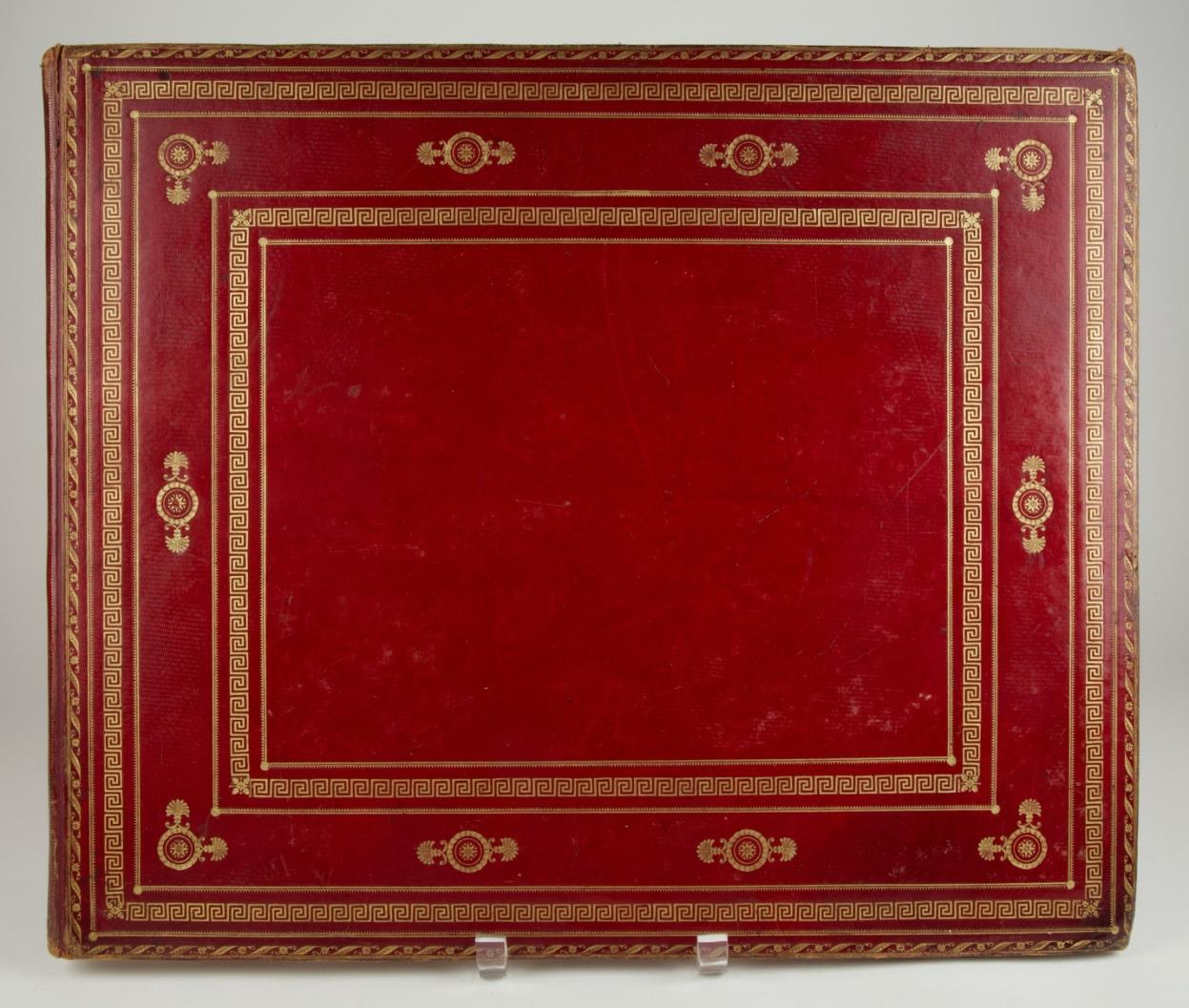
"The attitudes of arrested motion in the Sanquirico scenes from Vigano's ballets recall opera fully as much as, or rather more than, ballet. The canons of painting and sculpture which had dominated mime from the early days of the Greek masks are still evident in the Sanquirico record."
Winter: The Pre Romantic Ballet, p. 193.
"[Sanquirico] understood the pathos and mood that pervaded the new operatic creations of the contemporary lyric repertory of Bellini and Rossini, Donizetti and Pacini. He sought to achieve a closer relationship between the character of the opera and that of his decor. In designing for choral masses in war and peace, or devising
scenic effects for fire and storm, he planned his scenes so that the dramatic action should occur downstage. The composite harmony of his classical and romantic styles established a new trend in theatrical design. Whether his vast scenes were set in ancient Rome or in modern Milan, whether they reproduced the fiery spectacle of Pacini's Last Days of Pompeii, or the sombre atmosphere of a sepulchral Gothic hall, they were all designed with skillful articulation of architectural masses, with perspective to achieve spacial depth, and with chiaroscuro to dramatize light. Always a glorious if theatrical, authenticity haunted his designs. His insistence on pictorial verisimilitude heralded the advent of naturalist." Oenslager: Stage Design, pp. 150 151.
"His work represents a synthesis of all features of stage design between the last years of the eighteenth century and the first part in fact, the first half of the nineteenth century. Early on in his career he managed to reconcile the academic manner with that fresh, lively spirit which he had inherited from the Galliari family. Later he infused into classical forms a sense of monumental grandeur, at the same time tempering them with an exceptional feeling of space and light. His flexibility allowed him to assimilate the romantic trends which were opposing with increasing vigor what had become the crystalline rigidity of classical design. Sanquirico then, was able to combine the solemn and stately harmony inspired by Graeco Roman art (and sometimes by Renaissance art) with a taste for mystery and the picturesque derived from reminiscences of the Middle Ages, or from the pathos which was beginning to pervade some of the more sublime creations of Italian opera (notably the works of Bellini, Rossini and Donizetti). Far from resting content with a merely facile eclecticism, he achieved a unity of style comparable with that of Gonzaga." Monteverdi: La Scala: 400 Years of Stage Design from the Museo Teatrale alla Scala, Milan, p. 10.
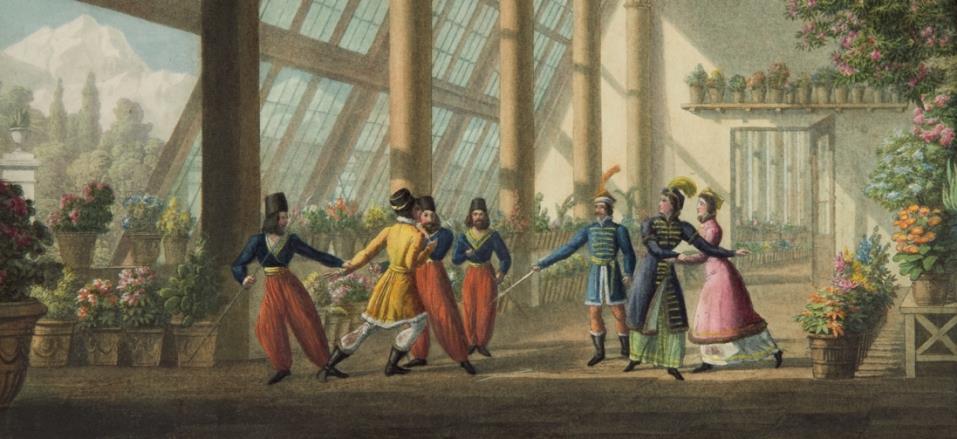
One of the very finest illustrated records of opera and ballet in Italy in the first half of the 19th century, with plates of a highly artistic nature superior in both design and execution. Sanquirico's influential designs, incorporating spectacular settings in ancient and exotic locales, provide important and highly valuable documentary evidence of contemporary opera and ballet stage action. (38599) $55,000
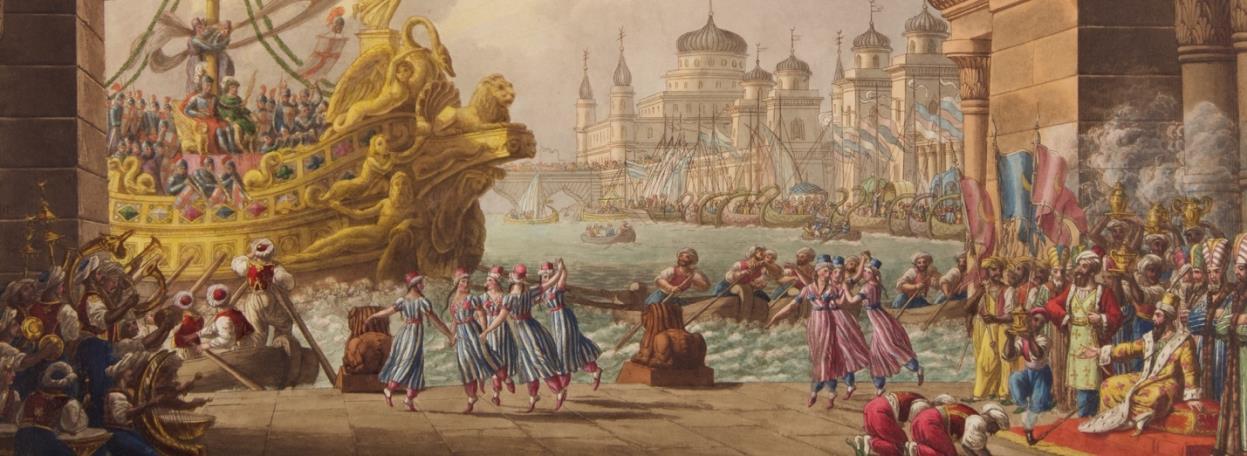
An Early Letter to a Close Friend, Offering Significant Insight into the Young Composer
14. SHOSTAKOVICH, Dmitri 1906 1975
Autograph letter signed ("D. Shostakovich") to Valerian Bogdanov Berezovsky, the composer's close friend and fellow student in Leningrad. 2 pp., densely written. Dated Moscow, 9 March 1925. In blackink. InRussian(withtranslation). Slightly worn and browned; creased at folds.
A lively and intimate early letter, replete with both musical and personal references, written when the composer was just 18 1/2 years of age, as he was completing his first symphony and adjusting to life in Moscow at the Conservatory.
"I am trying to publish a few dances and a trio. I took the manuscripts to the publisher today. I will play the pieces on Thursday and look forward to the outcome. I won't be happy if they don't understand the music. That will be a knock to my pride." Shostakovich goes on to admonish his correspondent regarding something that Belyaev had told Misha: "I ran into Belyaev recently. He turned to me saying, why did you tell Shostakovich that I told Mayakovsky about Mitya transferring to the Moscow Conservatory. You put me in an uncomfortable position ..." He then relates details about a visit to Yavorsky, saying that he "liked him very much ..." and continues to relate a story about an encounter with homosexual overtones.
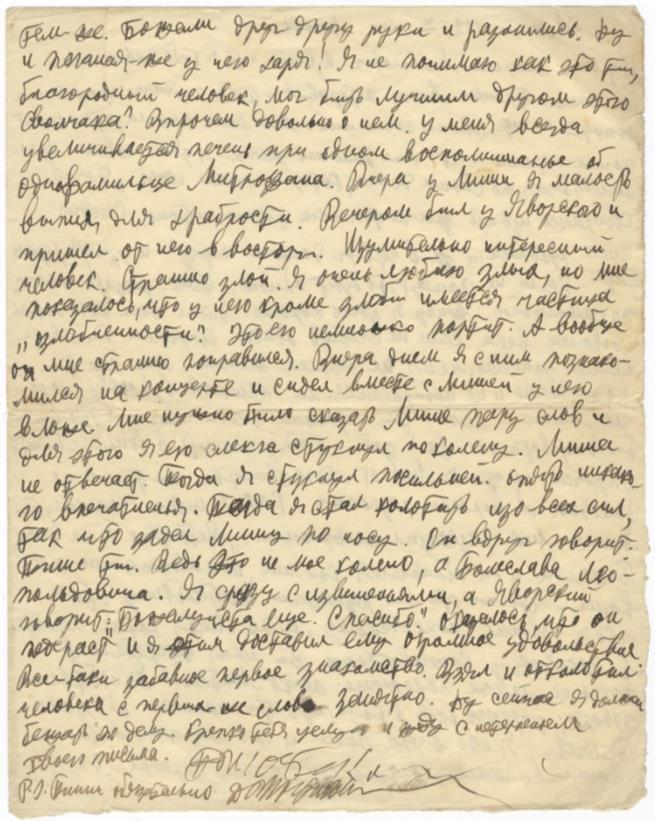
"In March 1925, when he was having difficulties with the last movement of the symphony, Shostakovich presented a selection of his music in Moscow. On this occasion the young Vissarion Shebalin made the bigger impression, but the visit at least helped Shostakovich to develop and inaugurate some important friendships with Shebalin, with the theorist Boleslav Yavorsky, and with the music loving marshal Mikhail Tukhachevsky
By April 1925, the [first] symphony was complete in piano score, and the orchestration was finished by 2 July. ... The 12 May performance, coincidentally the first radio broadcast from the Great Hall of the Leningrad Philharmonic, was a major public and professional success. ... The success of Shostakovich’s First Symphony catapulted him to international fame. The piece was taken up in rapid succession by Walter, Toscanini, Klemperer, Stokowski and others in the West, and it drew congratulatory letters from Milhaud and Berg. Its cachet lay partly in the fact that it was the first symphony composed in the Soviet Union to win a place in the general repertory and partly in that it had been composed by a teenager
Shostakovich "is generally regarded as the greatest symphonist of the mid 20th century, and many of his string quartets, concertos, instrumental and vocal works are also firmly established in the repertory. ... He played a decisive role in the musical life of the former Soviet Union, as teacher, writer and administrator. He was also an active pianist, frequently performing his own works until disability prevented him. His last concert appearance was in 1966." Laurel Fay and David Fanning in Grove Music Online
Bogdanov Berezovksy (1903 1971), a leading Russian musicologist, composer, and music critic, was a great friend of Shostakovich; Boleslav Leopol'dovich Yavorsky (1877 1942), a Russian musicologist, music teacher, and pianist, was a professor at the Moscow Conservatory from 1928 and a great influence on Shostakovich; he was, in part, responsible for arranging the first performance of Shostakovich's first symphony; "Misha" may refer to the young Moscow composer and friend of Shostakovich, Mikhail Cheremukhin; the reference to Myakovsky may be to the important Soviet poet, playwright, artist, and actor Vladimir Mayakovsky (1893 1930) (38754) $3,200
